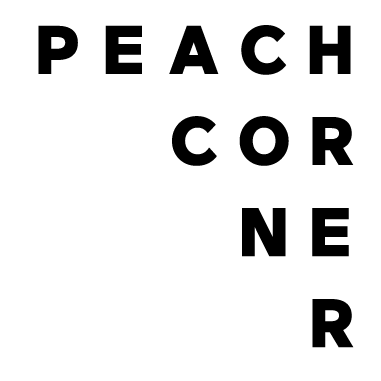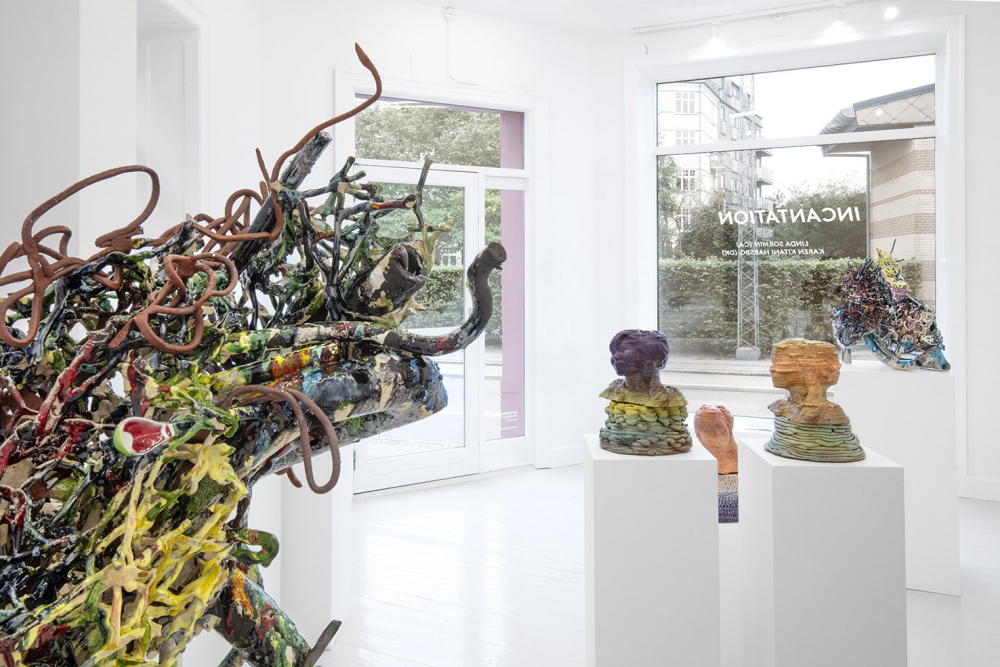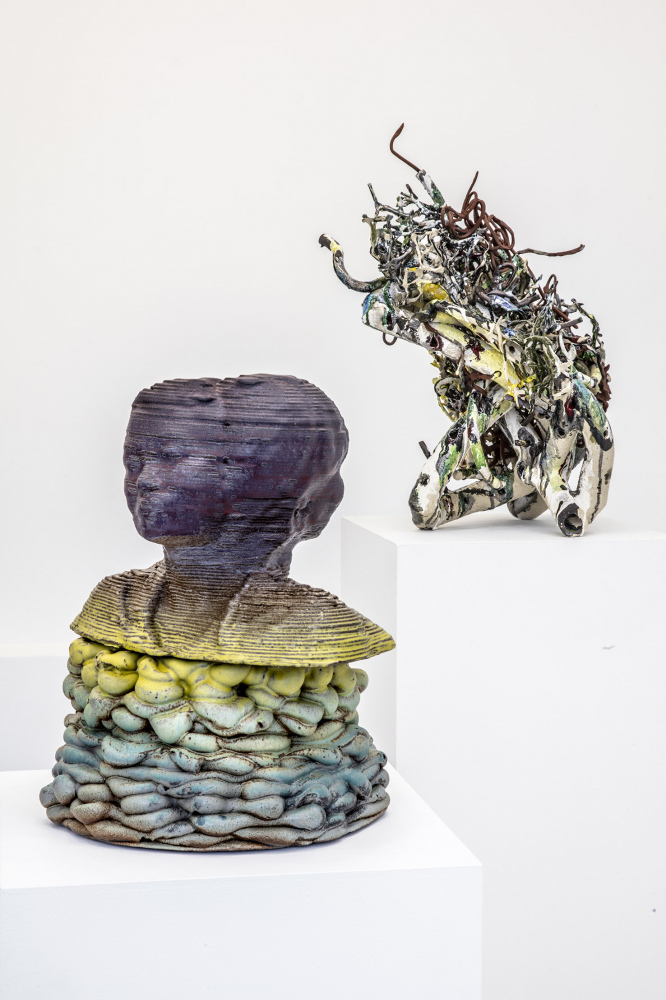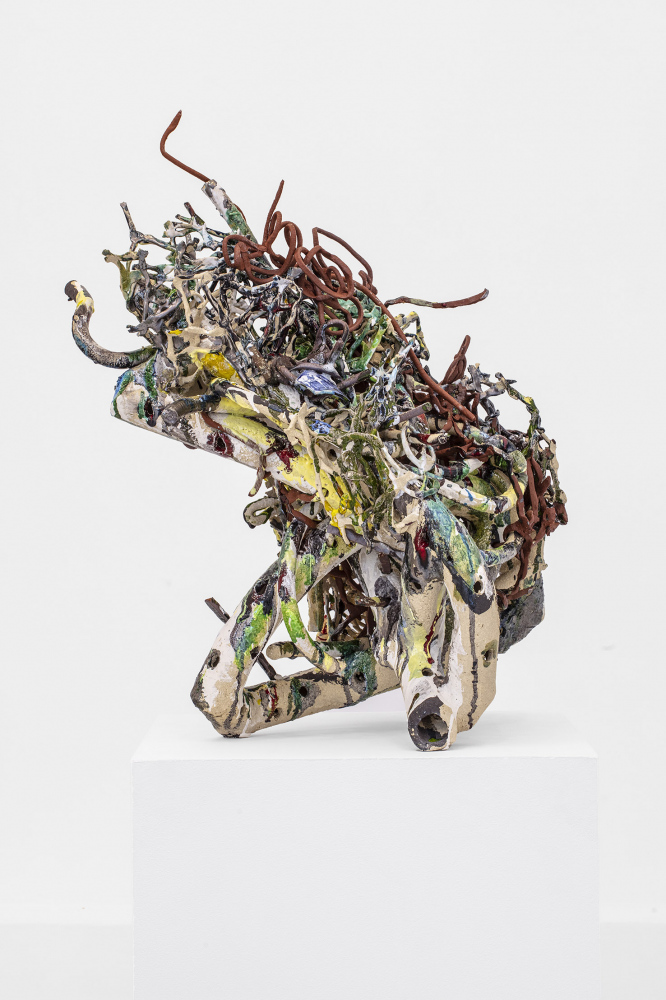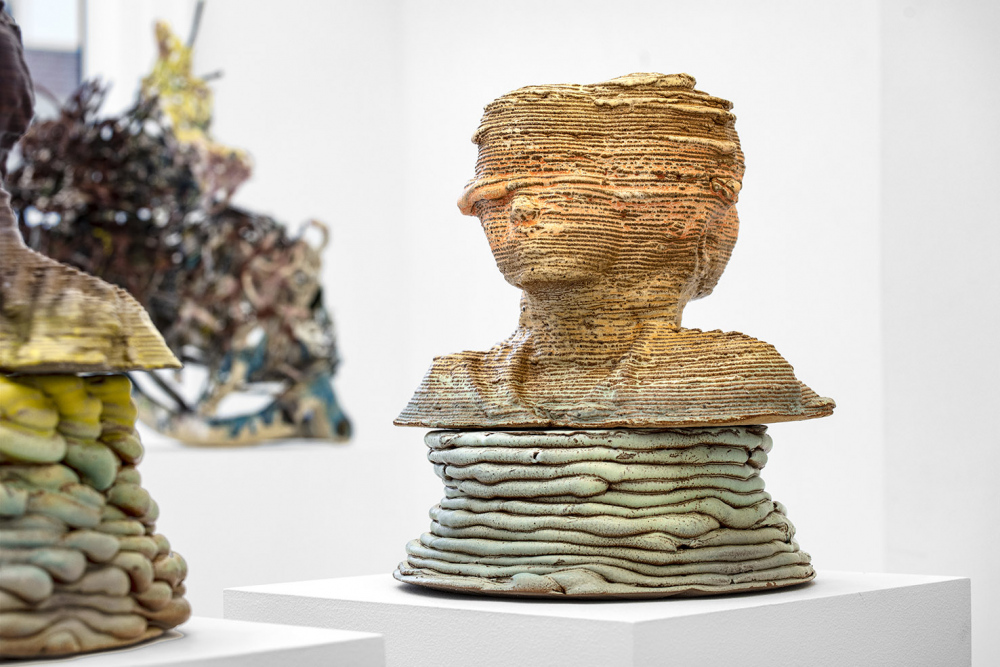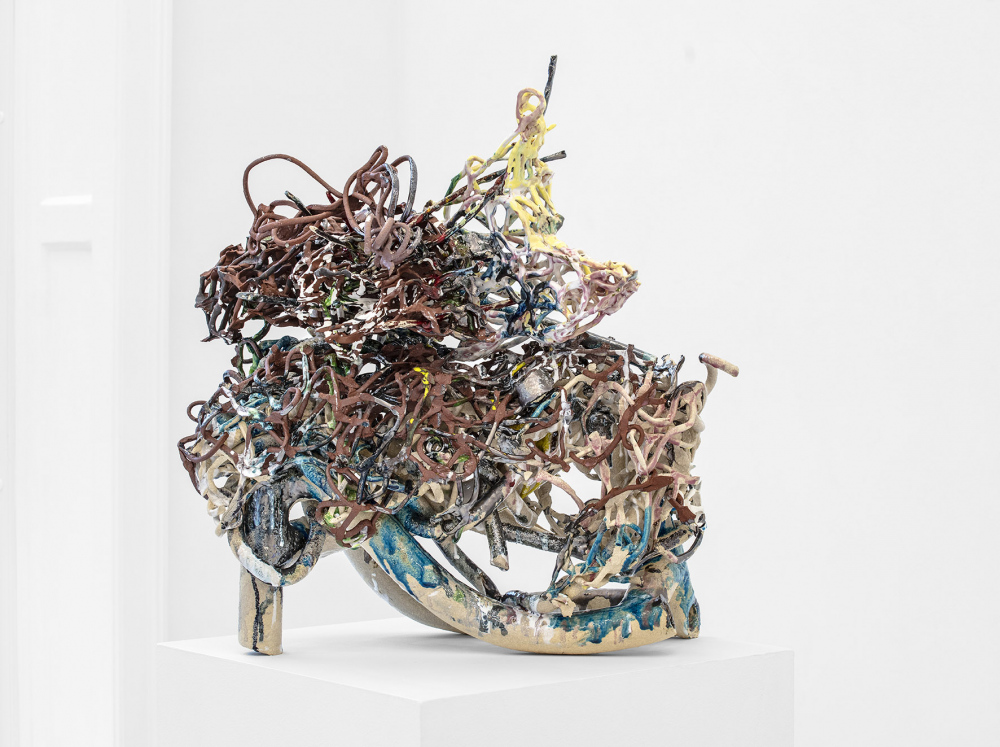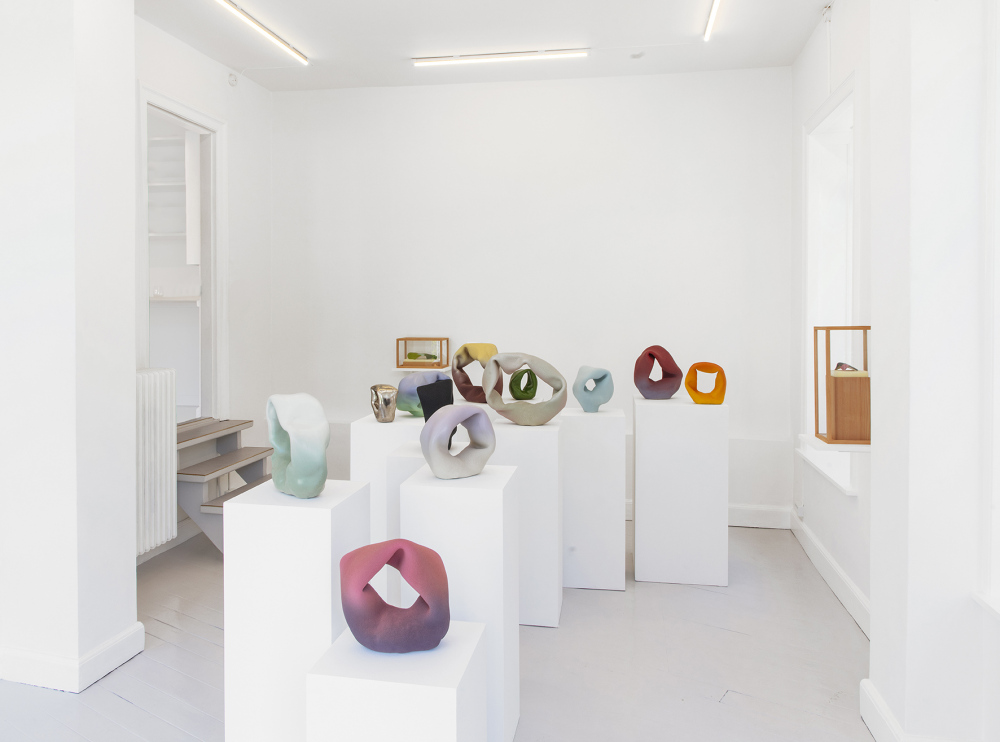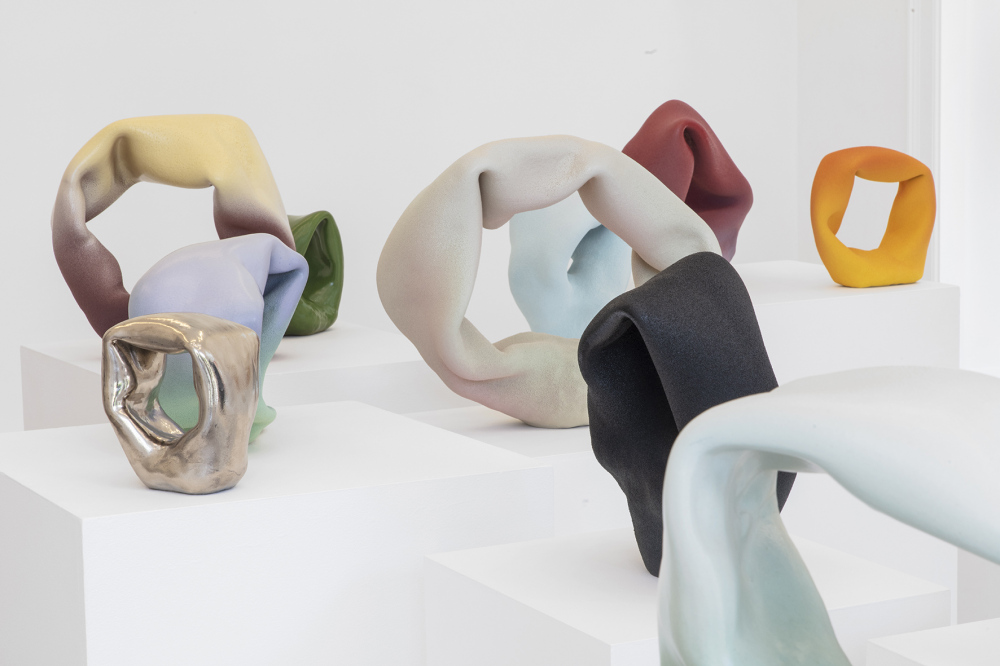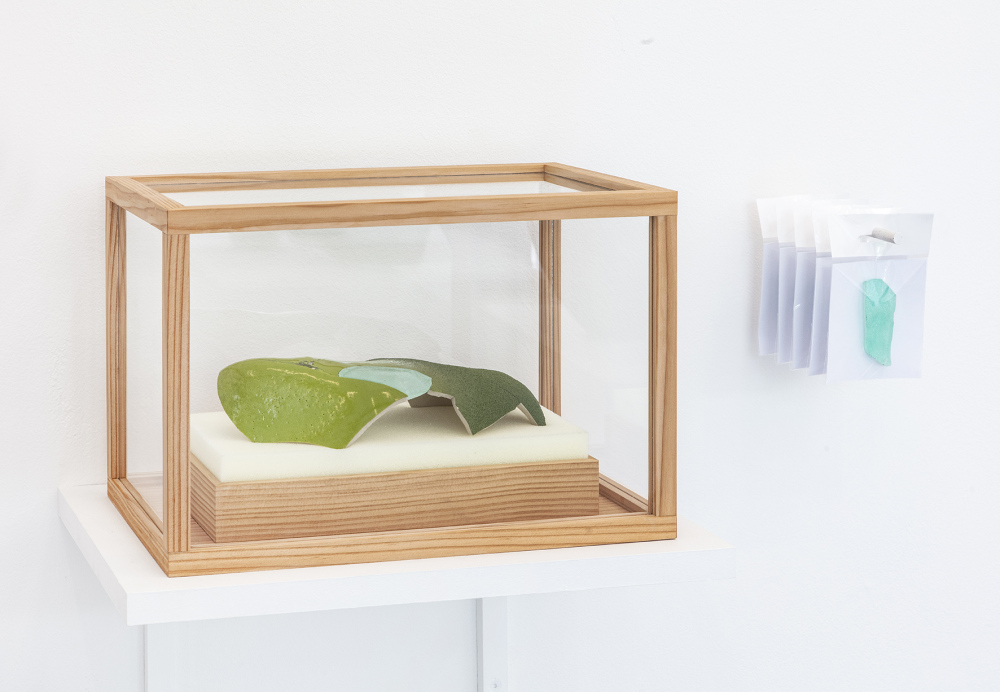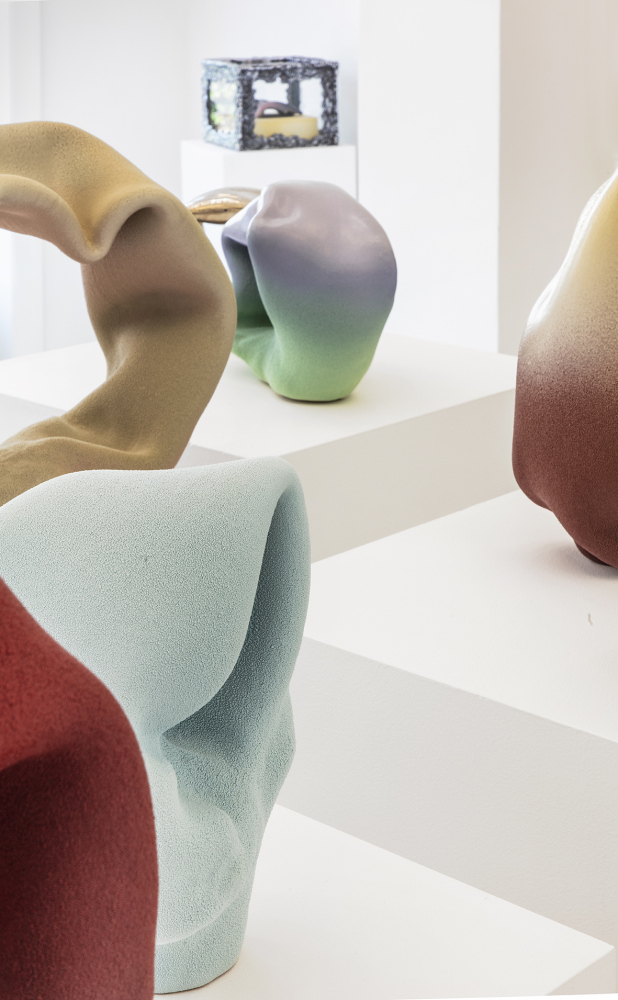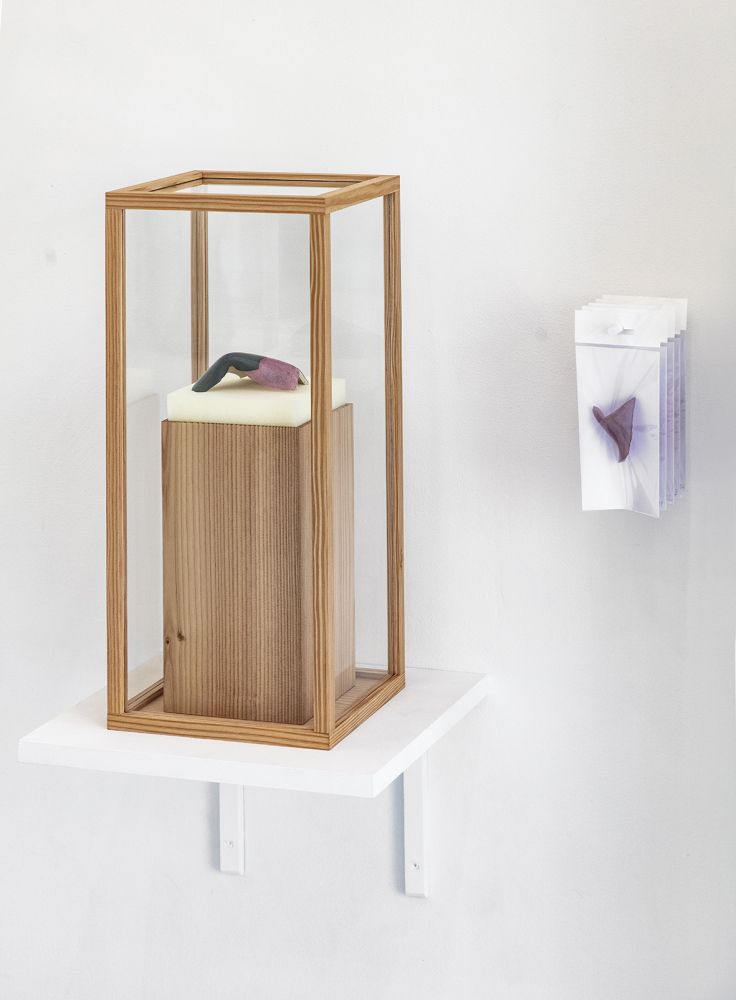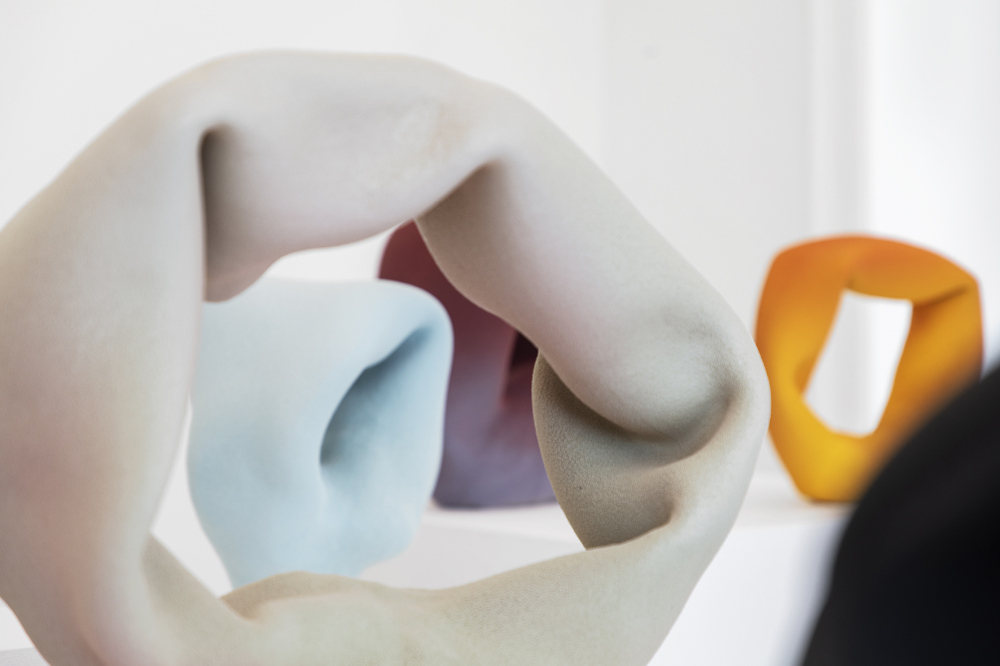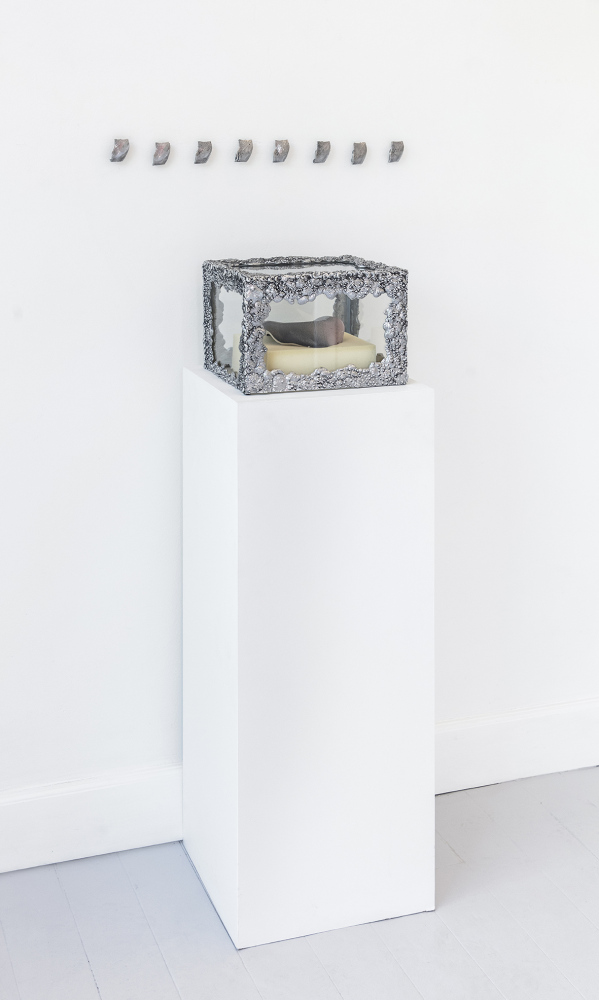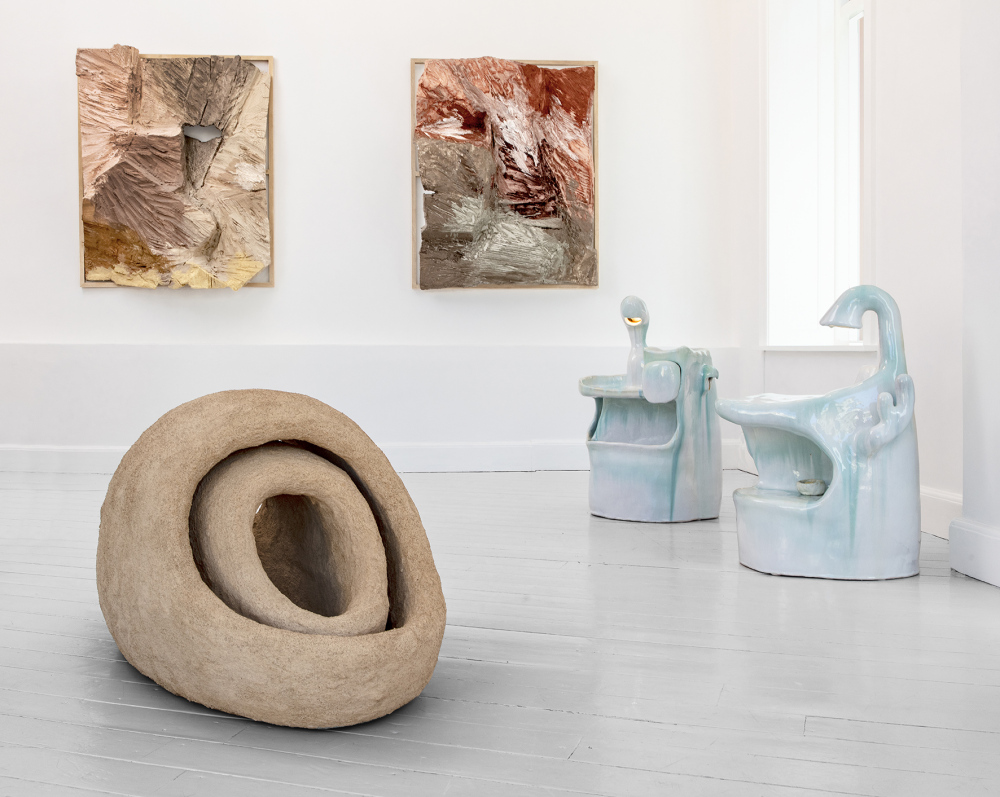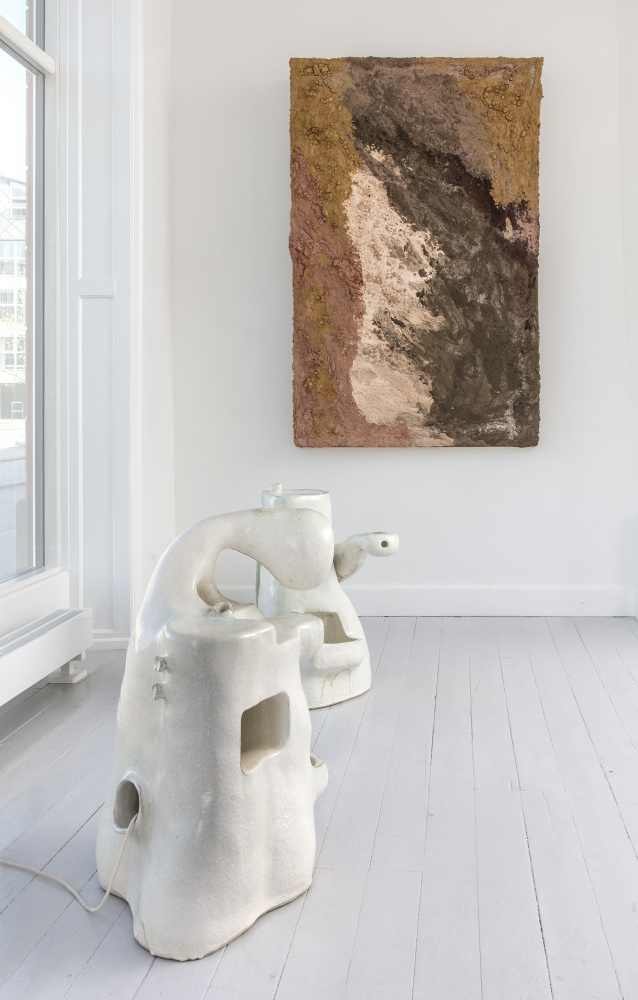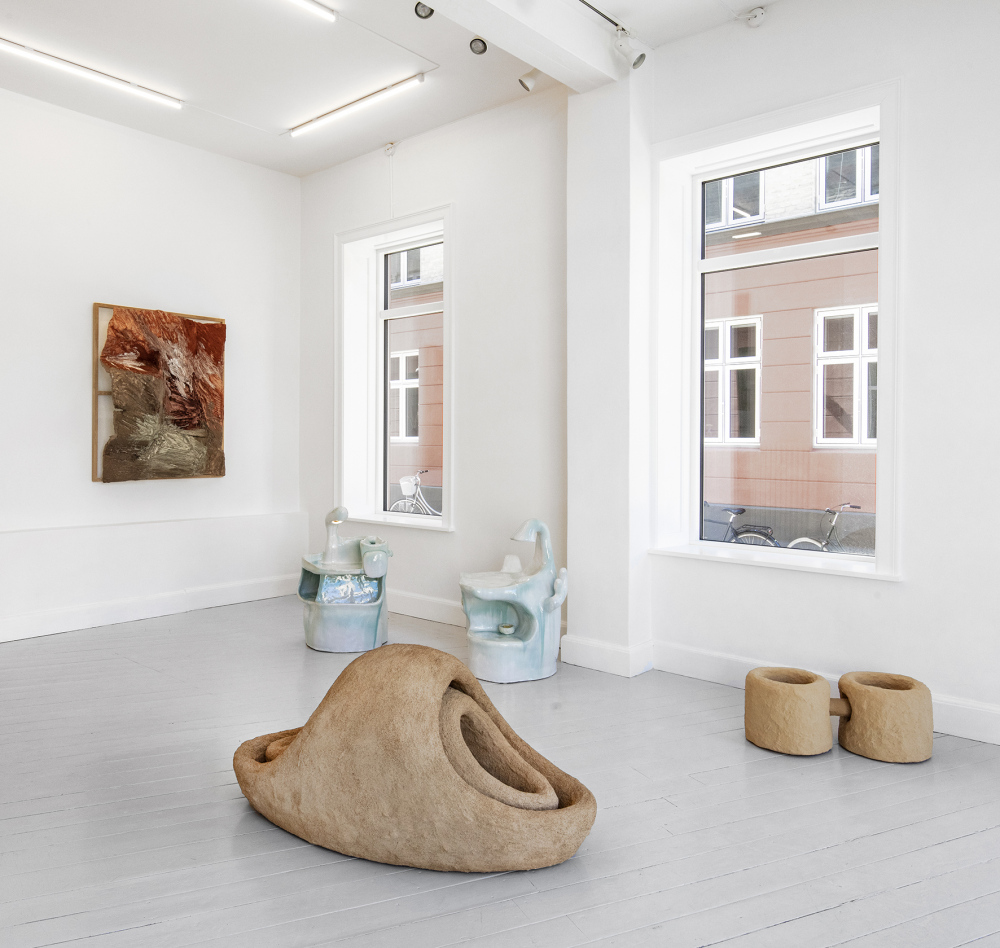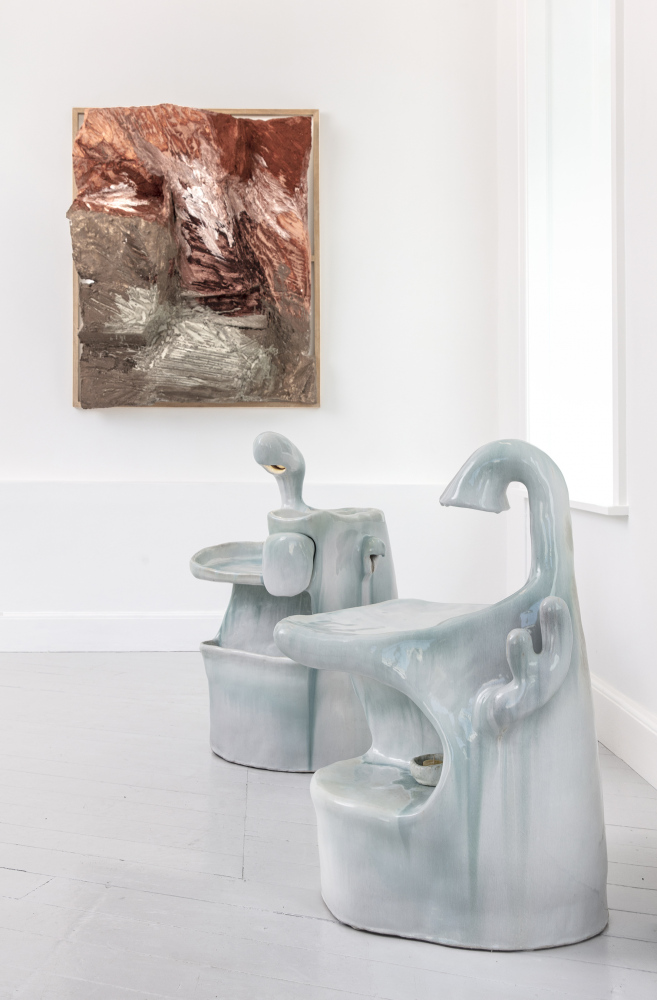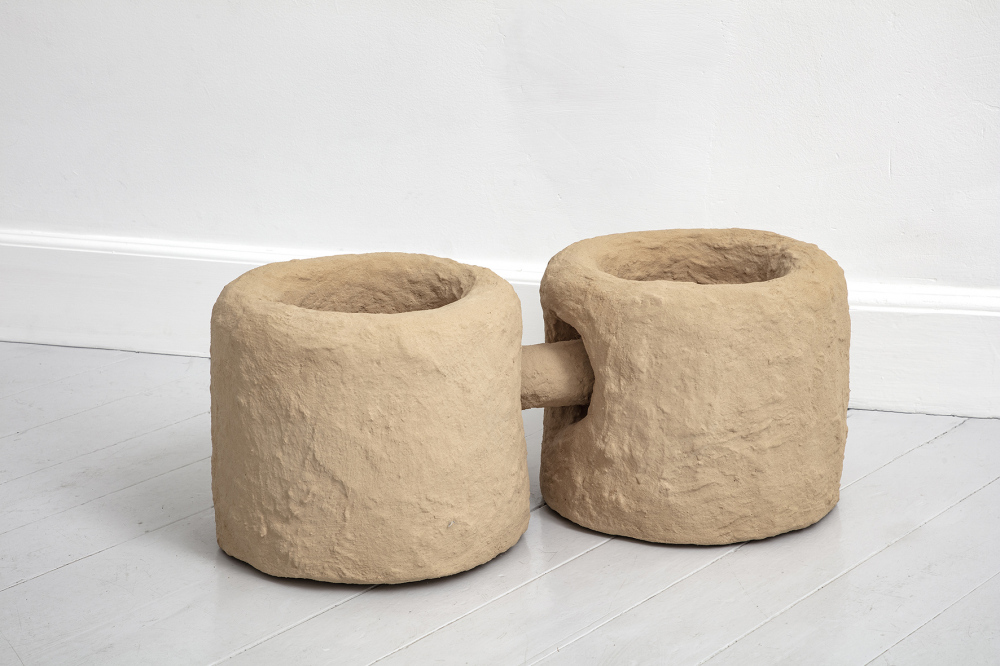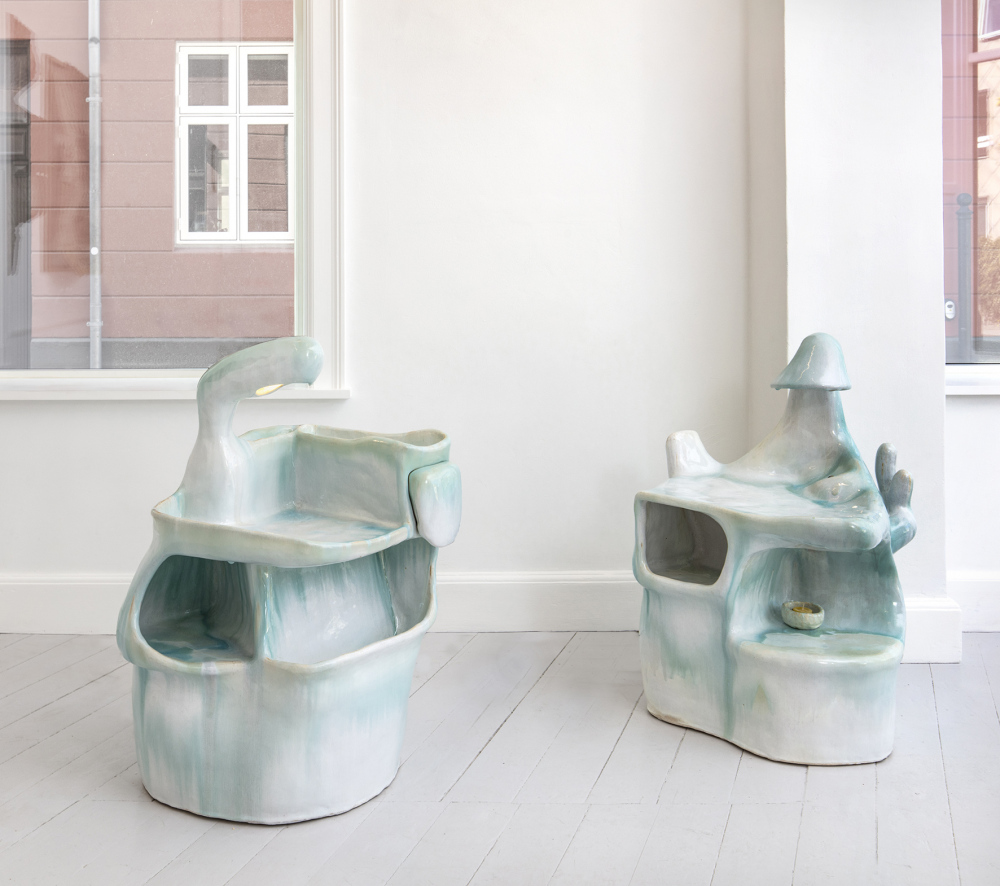PAST EXHIBITIONS - 2022
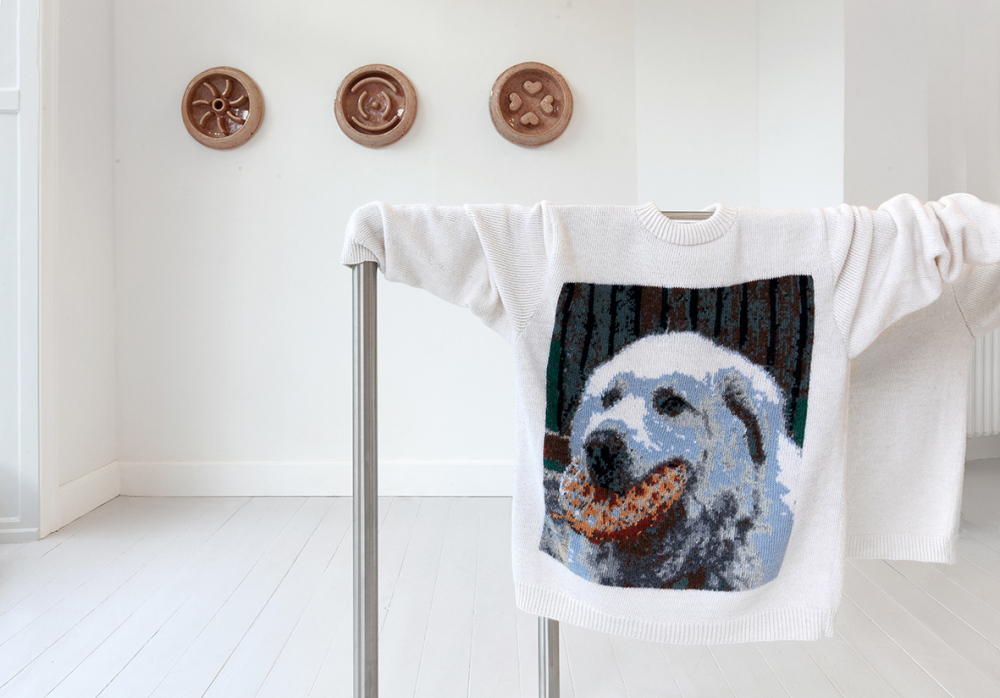
Slow Feeder II by Sisse Lee. Photo:Ole Akhøj
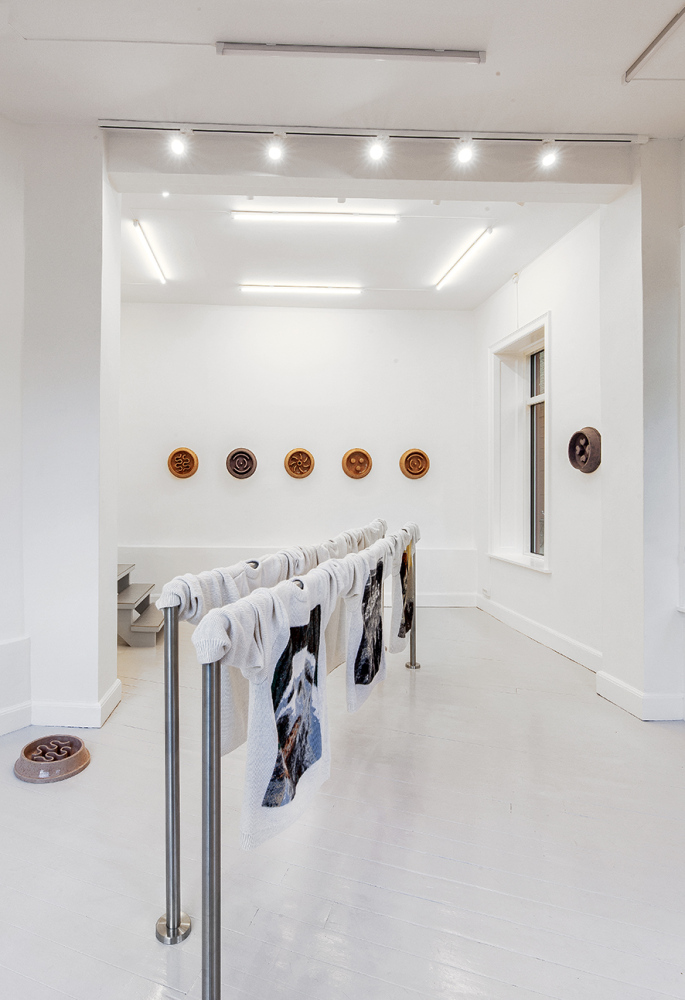
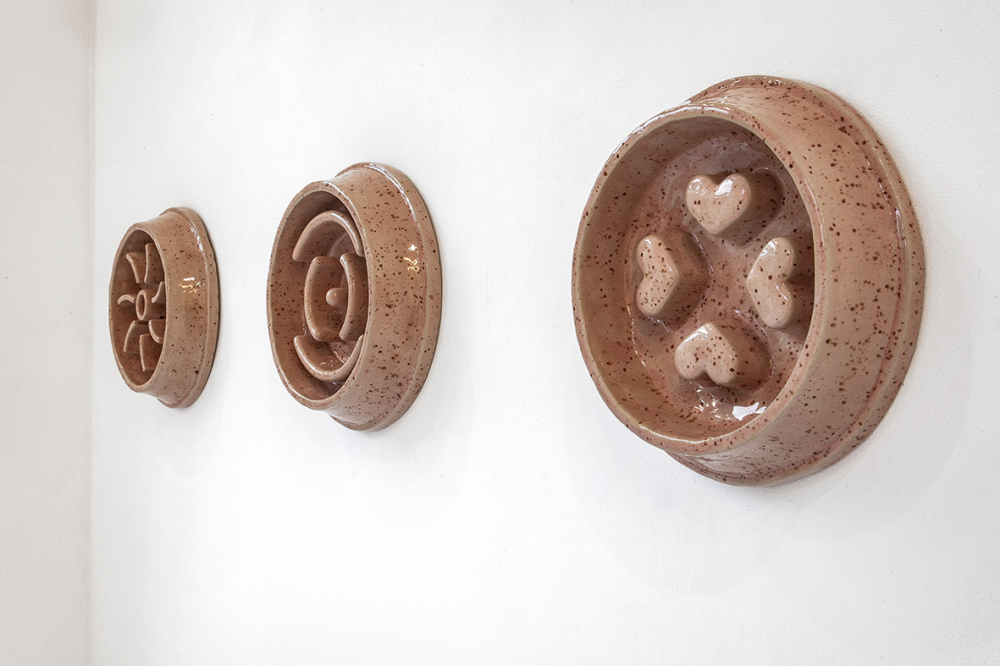
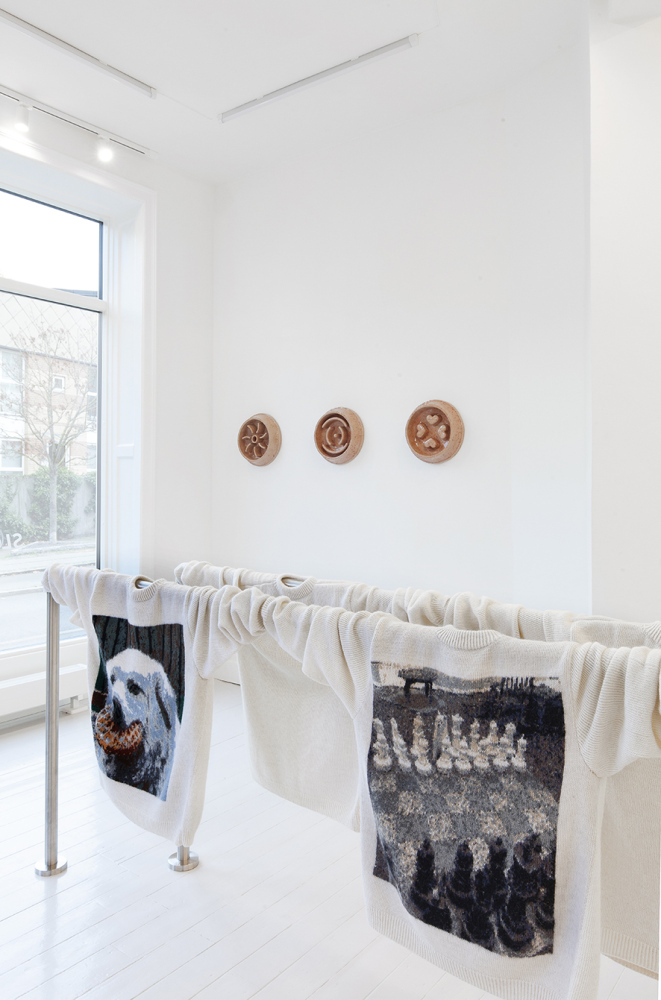
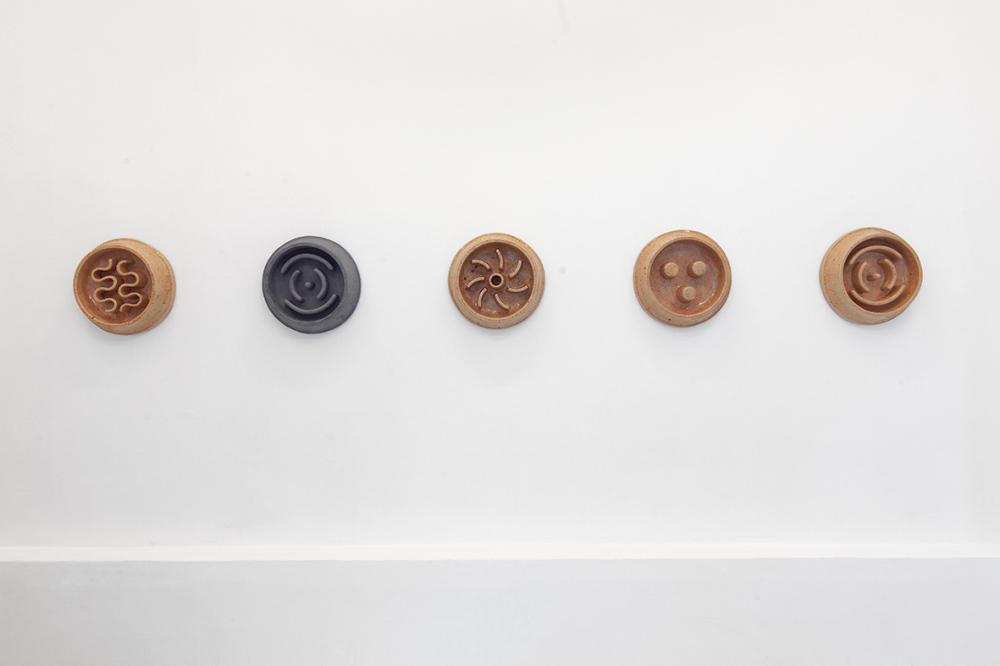
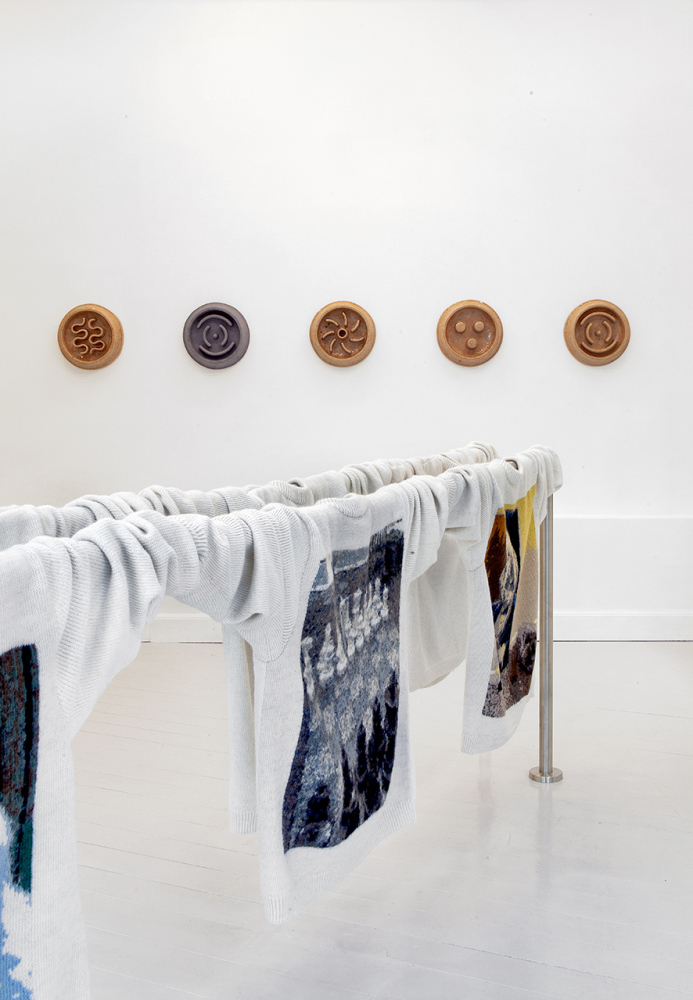
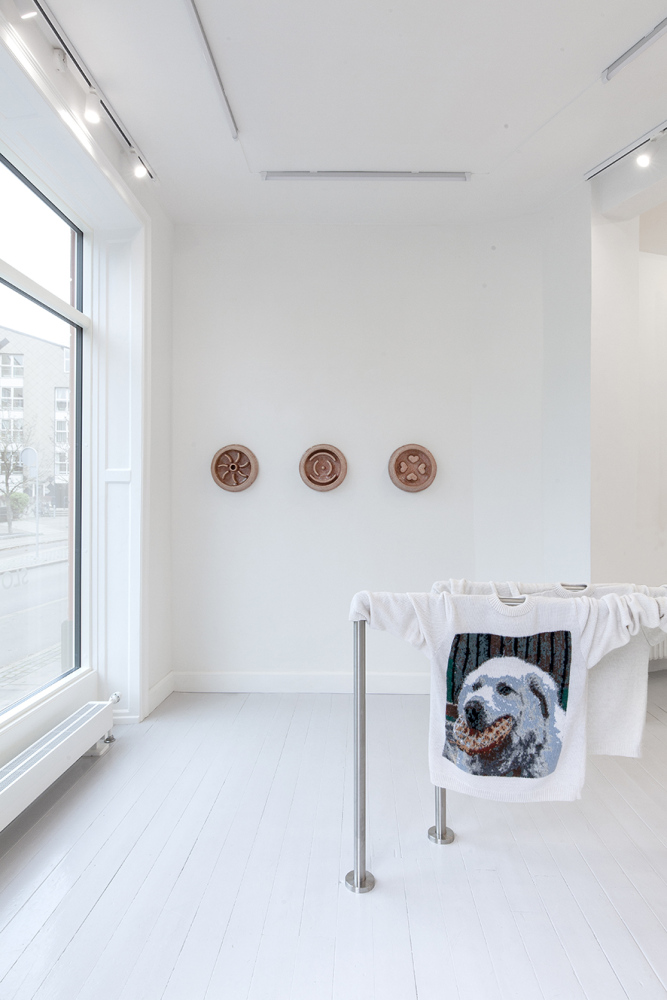
Slow Feeder II
Sisse Lee (DK/NO)
10 November – 17 December 2022
Opening address by art historian Emil Linnet
What happens when radical aesthetic advances suddenly appear in your dog’s food bowl? What does the shift in meaning look like when a vessel changes from utilitarian object to museum artefact? What value can we attribute to the slow activities of (arts and) crafts, given the emphasis on speed and reproducibility in our current image culture?
The dog has assumed the lead role in our digital image culture. What might that indicate? As an animal capable of feeling shame, the dog’s most remarkable quality is its ability to curb its urges through obedience training. Might it be that the image of the dog, man’s best friend, is helping us to visualize the burden of culture – civilization and its discontents?
The exhibition consists of scaled-up dog bowls in stoneware and a series of knitted textile artworks featuring images found online. The slow feeder dog bowls look like anaemic representations of formalistic modernism – abstract, geometric reliefs, a far cry from their functional origin. By contrast, the textile pieces have the form of utilitarian objects – knitted jumpers – but the amount of time that goes into their making stands in stark contrast to their source of inspiration, the online meme culture, which is characterized by quick, cheap and limitlessly reproducible production and dissemination.
Sisse Lee explores how objects and material environments change meaning over time and what this reveals about us. Slow Feeder II draws inspiration from industrially manufactured feeding bowls for binge-eating pets and the prominent role of these animals in the constant stream of online images. The bowls’ form and material qualities have been enlarged and distorted in various ways in order to make the familiar unfamiliar and vice versa.
Sisse Lee (b. 1987, Denmark) lives and works in Oslo. She earned a bachelor’s degree from the Royal Danish Academy – Design, Bornholm in 2016 and a master’s degree in medium- and material-based art from Oslo National Academy of the Arts in 2018. Sisse Lee has exhibited both in Denmark and abroad, including at Talente2019 in Munich, the Biennale for Craft & Design and CHART Art Fair in Copenhagen, COLLECT in London, Kunsthall Grenland in Porsgrunn, Norway, RAM galleri, Oslo and, most recently, a solo exhibition at Østfold Kunstsenter in Fredrikstad, Norway.
She has received working and travel grants from the Danish Arts Foundation and was awarded the three-year working grant from Arts Council Norway in 2022.
Download press release + images
The exhibition was supported by Norwegian Crafts and the Ministry of Foreign Affairs in Norway.
INCANTATION
Linda Sormin (CA) and Karen Kitani Harsbo (DK)
29 September – 5 November 2022
Opening address by Museum Director, art historian Teresa Nielsen, Vejen Kunstmuseum
‘Double, double, toil and trouble / Fire burn, and cauldron bubble.’
Weird Sisters in Shakespeare’s Macbeth
Using clay and fire, two ceramic artists, Karen Kitani Harsbo and Linda Sormin, build stories in space – piece by piece, layer by layer – to create sculptural forms and sensations that conjure and reflect their origins, rituals, personal myths, tensions and shadow selves.
Incantation: Spells spoken aloud resonate across time and cultures, giving access to a world in between what we see and know. They make it possible to connect to other powers and energies – forces that enchant and transform the familiar.
Fire: Lay your hands here, in this phoenix material spitting incantations through flame. The divine, forming the first humans in clay, followed its curiosity, blew its high-fire merciless breath through their every chamber. Godly godless dragon scorching razed earth, heat working over time – (what more can we withstand)?
Sensation: Wake side by side in this century, go to ground, claw the dirt for clues. Clay invites touch, smell, sight and even sound, as potters tap unfired walls to discern thickness. This somatic interaction – gathering knowledge through one’s body – is at the core of global ceramic traditions and extends beyond the vessel to clay sculpture, video and mixed-media experience.
Linda Sormin presents recent glazed ceramic sculptures made with rhythmic touch and loose tangles of clay as well as video works unravelling familial and cultural narratives. Generating from ceramic and digital glitch (including found porcelain shards and fragments from family conversations), Sormin’s works are abstract renderings of diasporic experience. In the video Babel (unscripted), Tatlin’s monument and the Tower of Babel conflate, reimagined and retold as a form turning in a rural stream.
Karen Kitani Harsbo shows her recent work of portrait busts of two women who might be two different persons or maybe the same person containing different versions of her within. The sculptures also refer to the ancient Roman figure of Janus, the god of beginnings and transitions, who looks both to the past and to the future, which is embodied in these ceramic sculptures, a medium resting on a vast cultural past and made in the novel method of 3D digital printing. Harsbo has experimented with the influence of the material on the digital method, giving the same digital shape different outcomes, depending on the flow and consistency of the clay and thus giving a diversity of artistic expressions and moods to the individual sculptures.
Linda Sormin explores fragility, upheaval, migration, survival and change through sculpture and site-responsive installations. Born in Bangkok, Thailand, Sormin moved to Canada with her family as a child. She studied English literature at Andrews University (BA, 1993) and worked in community development in Thailand and Laos. She graduated from the New York State College of Ceramics at Alfred University (MFA) in 2003. She lives and works in New York City and is associate professor of Studio Art at NYU. Sormin’s work is in private and public collections, including Renwick Gallery at the Smithsonian American Art Museum, Gardiner Museum, Everson Museum of Art and CLAY Museum of Ceramic Art Denmark. She was a participant at European Ceramic Workcentre in 2021, creating new works for Ceramics in the Expanded Field: Sculpture, Performance and the Possibilities of Clay at MASS MoCA, North Adams, MA, USA, Expanded Forms at Messums Wiltshire in the UK and Incantations at Peach Corner Gallery, Copenhagen.
Karen Kitani Harsbo graduated from the Danish Design School 1987 and teaches at the Royal Danish Academy of Fine Arts, Copenhagen, where she is associate professor of Ceramics, 3D Printing and Sculpture. She uses clay to explore the journey of material knowledge handed down through ages and cultures, formation of material on earth and in space, digital technologies and 3D printing and, most recently, the entanglement of nature, human and fungi. She has given workshops and lectured at multiple institutions and been involved in several artistic research projects. She is the recipient of grants from the Danish Arts Foundation, Ellen og Knud Dalhoff Larsens Fond, Anne Marie Telmanyi, født Carl-Nielsens Fond and Danmarks Nationalbank’s Anniversary Foundation of 1968. Harsbo’s work is included in private and public collections, including Vejen Kunstmuseum, Designmuseum Danmark and CLAY Museum of Ceramic Art Denmark. Special thanks to Oskar Koliander for assistance with the exhibition.
Download press release + images
Nymphs of Vingerling
Esben Kaldahl (DK)
18 August – 24 September
Exhibition curator: Hilda Piazzolla
Opening address by Svala Vagnsdatter Andersen, PhD.
With the exhibition Nymphs of Vingerling Peach Corner hosts a solo presentation by Esben Kaldahl, a young talent who is fascinated with the seductive qualities of things: what is it in an object that speaks to us? What is it that draws us closer, makes us want to touch and possess? Through two interconnected series of works Kaldahl examines how we form attachments with the objects we collect and how we imbue things with emotional and personal significance.
Kaldahl describes his sculptures as ‘nymphs’, a reference to the mythological creatures, who exist in the border zone between body and nature: an Oceanid is both human and river, a Dryad is both a tree and a body. Kaldahl’s nymphs appear as alluring objects, organic forms in white stoneware with tactual glaze surfaces that draw us in. Their forms initially appear abstract, but on closer inspection, they reveal elements of a body: an elbow, the back of a knee, a roll of belly fat. Each nymph sculpture has its own name, such as ‘Tir’, ‘Ort’ or ‘Mal’; an onomatopoetical reference to the object’s sound. The notion of sound is also evoked by the sculptures’ openings, which might resemble singing mouths. The onomatopoetical names could be imagined as the sound made by a strange animal, the sound of nature or a symbol in an alphabet, a rune, an invocation.
Along with the Nymphs, the exhibitions presents a number of reliquaries, each containing a fragment of a nymph. The reliquaries are a study of magical objects, as we know them from religious contexts, where a relic might be a fragment of the body of a holy figure, such as a bone or a mummified body part, or an object that is closely associated with the figure. In extension of each magical artefact hangs a series of ‘souvenirs’ that replicate a part of the original. The relationship between original and replica is a study in the way the magic properties of an original object can reside even in a cheap key fob, a magnet or a lighter. In spite of their obvious lack of monetary value, these objects may hold great emotional and personal significance.
Kaldahl’s relics draw us in with their sensuous scenography and playfully offer an object we can imbue with significance, a vessel for our emotions.
Esben Schakenda Kaldahl (b. 1992) graduated from the Royal Danish Academy – Design in Copenhagen in 2020. His practice revolves around human relationships with objects and their storytelling capacity. In 2021 he received the home interior design magazines’ Design Award as craft maker of the year. In 2021 and 2022 he was awarded the Danish Arts Foundation’s working grant for new craft and design talents. Selected exhibitions: Confessions, group exhibition, Alcova, Milan, 2022; Cup, group exhibition, Art Week, Copenhagen, 2021; Post.Service, group exhibition, Tableau, Copenhagen, 2021; Ukurant (Obsolete), group exhibition, 3daysofdesign, Copenhagen, 2020; Automatons, solo exhibition, Tableau, Copenhagen, 2019; Table Talks, group exhibition, Pillnitz Palace, Dresden, 2019.
Download press release + images
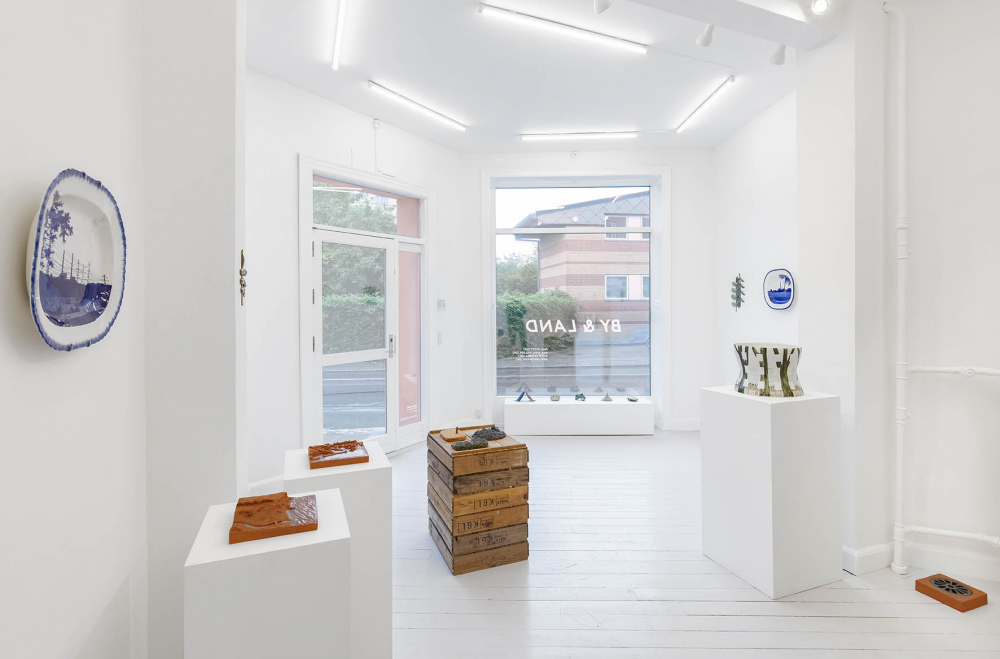
Photo by Ole Akhøj
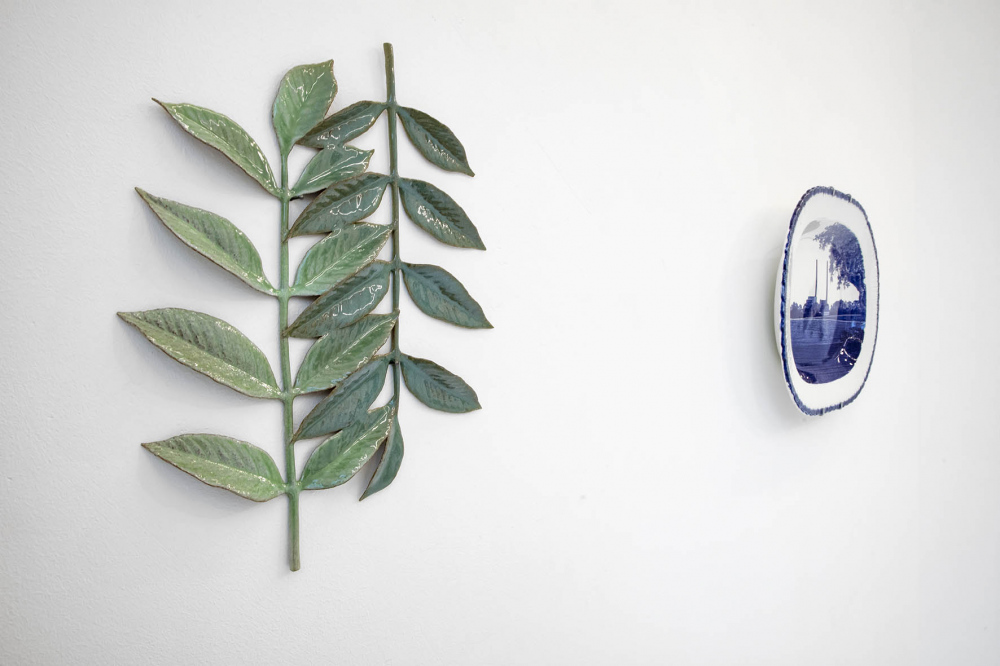
Photo by Ole Akhøj
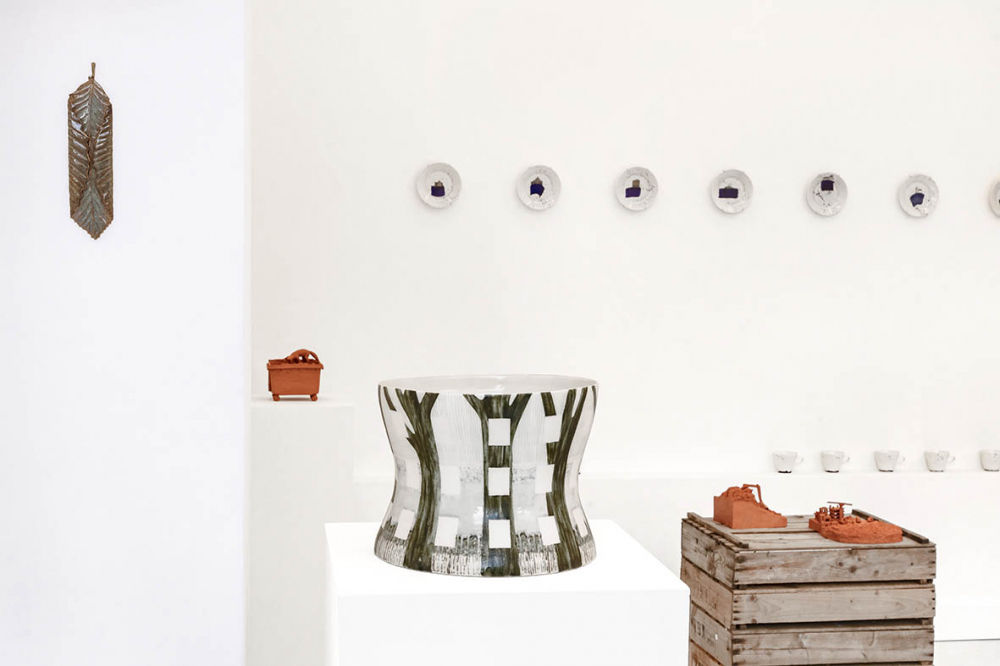
Photo by Ole Akhøj
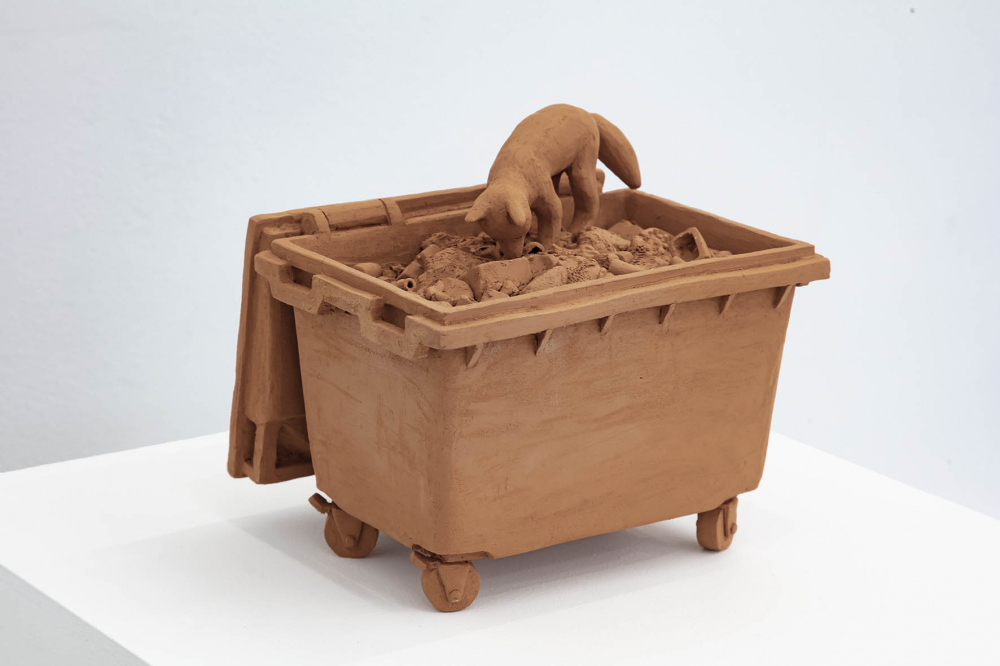
Photo by Ole Akhøj
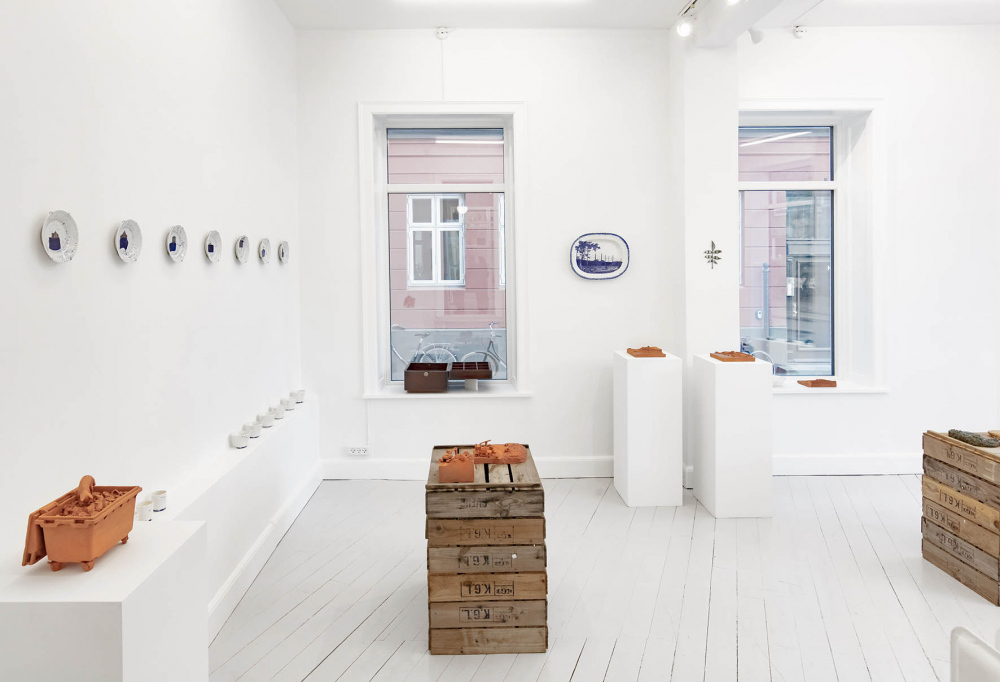
Photo by Ole Akhøj
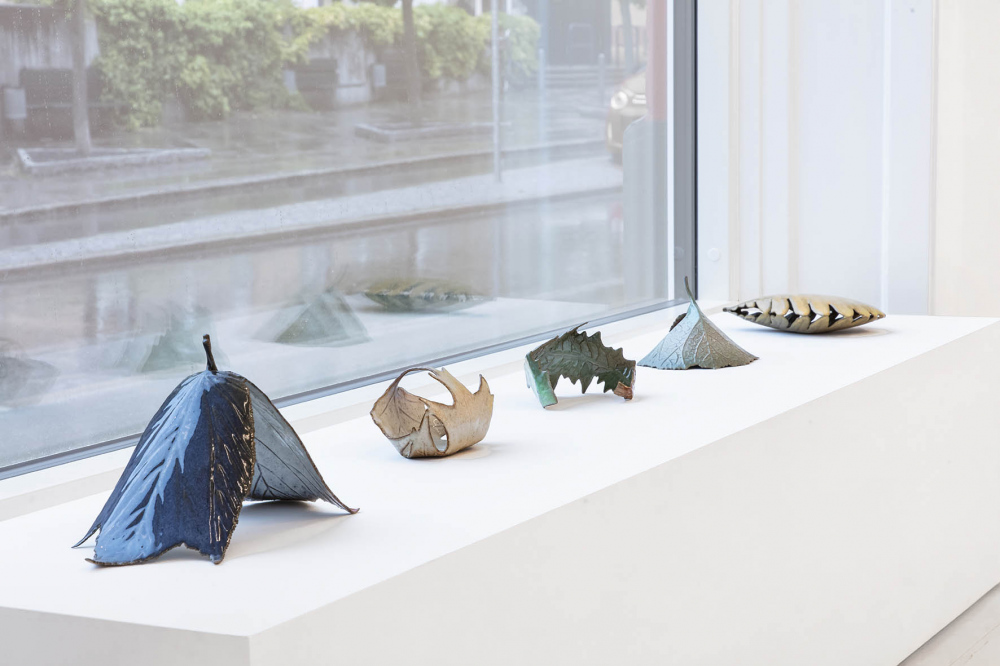
Photo by Ole Akhøj
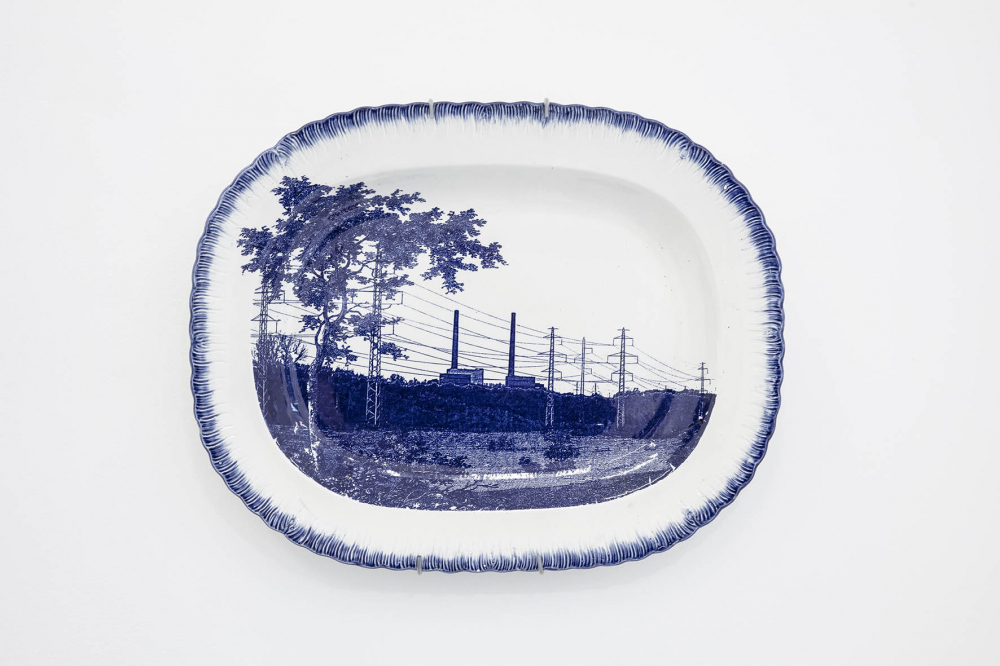
Photo by Ole Akhøj
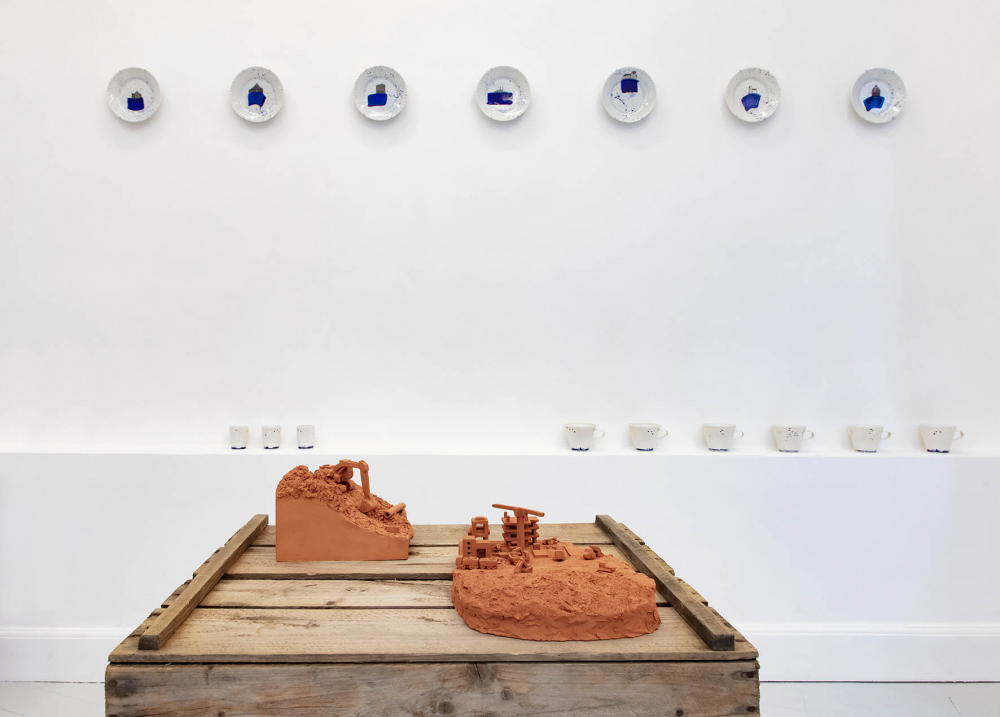
Photo by Ole Akhøj
CITY & COUNTRY
Paul Scott (UK), Marianne Nielsen, Inger Heebøll and Ann Linnemann (DK)
2 June – 9 July 2022
The exhibition was curated by Ann Linnemann
Nature has moved into the city, and the city has moved to the country. Sustainable thoughts and actions are now also focusing on urban environments and green areas – full of weeds and wild plants. Culture and nature live together in harmony or wage war on each other. Our world is facing the challenge of global warming and natural disasters but is also soothed by a dream of simple country living.
In this exhibition, these contemporary forces and ideas are related to the ceramic tradition for craft and industry in ceramic pieces that explore poetic, conceptual or idealistic paths and routes.
In contributions with political undertones, the four ceramics artists offer insights into the universe that emerges when city and country meet. From their respective vantage points they guide the audience into personal and artistic interpretations of the theme of CITY & COUNTRY – directly and clearly moulded, printed or painted on ceramic objects in naturalistic, idealist, ironic or reflective expressions, depending on temperament. A diverse experience with a wealth of different visions, all revolving around the wonders of nature and the man-made factors that shape our world – for better and worse.
Ever since Rosseau and the beautiful portrayals of rural or wild nature by the Danish Golden Age painters as well as the fabulous nature morte tradition with naturalistic still lifes of dishes of rotting fruit and impressive displays of hunting game, artists have sought to present nature, life and death in unusual and thought-provoking ways. This aesthetic presentation goes hand in hand with the spooky and unsettling aspects we sometimes forget in our enthusiasm over the beauty of the works.
British Paul Scott’s landscape pieces continue a new line in his artistic oeuvre: Cumbrian Blue(s), which features painted and printed images. Danish Scenery, Stigsnæs is an antique dish decorated with silk-screen prints. In a simple approach, Marianne Nielsen incorporates leaf images into a cultural expression. The leaf remains a leaf but also turns into something new in an interesting contrast between the artificial and the natural. Inger Heebøll’s work series Nye habitater (New habitats) is a series of tableaux in Danish earthenware based on observations and ideas of the impact of human behaviour on our surroundings. What happens when city and country meet, as we continue to encroach on nature, and nature has to find room on human terms? Ann Linnemann examines narratives about the notion of living in the country, being in two places at once, moving between city and country. From the vessel København (Copenhagen), painted with glaze, and a set of wheel-thrown cups with blue prints to found objects from an old fisherman’s cottage.
Paul Scott, UK (b. 1953) earned a PhD from Manchester Institute for Research and Innovation in Art and Design, Manchester Metropolitan University, in 2010. S. Martin’s College, Lancaster, B. Ed. (2.1.Hons) Art and Design 1976–77 and Certificate of Education 1972–75. Paul Scott’s work is represented in public collections all over the world, including the National Museum in Oslo, V&A in London, National Museums in Liverpool and the Smithsonian Institute and the Brooklyn Art Museum in the United States. Has created large works of art in Hanoi, Vietnam and the sculpture garden surrounding the International Ceramic Research Centre Guldagergaard in Skælskør, Denmark. Professor of ceramics at Oslo National Academy of the Arts (KHiO) 2011–18. Scott’s current research project New American Scenery has been made possible by an Alturas Foundation artist award, Ferrin Contemporary and funding from Arts Council England. Over the past 22 years, Scott has repeatedly exhibited in and visited Denmark. www.cumbrianblues.com
Inger Heebøll (b. 1969) graduated from The Danish Design School, glass and ceramics line, in 1998. Selected exhibitions: Atrium. The Living Pot, CLAY Museum of Ceramic Art Denmark, 2018; Danish Biennale for Craft & Design, Carlsbergbyen, 2015; Danish Biennale for Craft & Design, 2013, The Round Tower, Copenhagen. The Hetsch Medal, bronze. The Danish Arts Foundation’s working grant in 2015 and project funding in 2018. Nominated for the Danish Biennale Award, 2013. http://dkod.dk/medlem/?medlem=45
Marianne Nielsen (b. 1971) graduated from Design School Kolding, the line of ceramics and glass, in 1999. Selected exhibitions: Ceramic Momentum – Staging the Object; Nature. Traces & Reflections; Grand Designs – Clever Hands; CLAY Museum of Ceramic Art Denmark; Bend, Bubble and Shine, Hostler Burrows Gallery, New York and Los Angeles; Flower Vases, solo exhibition, Ann Linnemann Galleri, Copenhagen; Danish Biennale for Craft & Design, 2017. Has received numerous grants from the Danish Arts Foundation, Annie og Otto Johs. Detlefs Keramikpris, Danmarks Nationalbank’s Anniversary Foundation of 1968 and Ole Haslunds Kunstnerlegat. www.mariannenielsen.com
Ann Linnemann (b. 1957) graduated from the School of Decorative Art, Copenhagen, in 1989. Trained as a potter at H. A. Kähler 1979–83. Research scholar, Arizona State University, USA, 1993–94. Co-founder of Peach Corner 2021. Owner/curator of Ann Linnemann Galleri 2008–21. Own studio in Denmark since 1996. Represented in several international exhibitions and public collections. Has received numerous grants from the Danish Arts Foundation, the OJD Motivation Award, grants from Danmarks Nationalbank’s Anniversary Foundation of 1968, Ole Haslunds Kunstnerlegat, Helpmann Academy Award (AU) and Banff Arts Centre Residency Award (CA). www.annlinnemann.blogspot.com
Download press release + images
FICTIONS
Carlo Lorenzetti (USA/NL) and Carl Emil Jacobsen (DK)
21 April – 28 May 2022
Throughout the history of sculpture, the moving body has been represented as living flesh, emulated and frozen in hard materials. Design, on the other hand, deals with things that are intended to be used by the body: gripped, raised, sat on, snuggled up inside ... The Fictions exhibition juxtaposes objects by Carl Emil Jacobsen and Carlo Lorenzetti that, each in their way, exist in the borderland between art and design. At first glance, the objects seem familiar, like ‘things’ we recognize from our domestic and private environment, but on closer inspection, they are ambiguous and startling. The body’s functions and movements are perceived as a possibility. The distinction between the acting body and the passive thing is blurred, and a soft, organic expression evokes a sense of movement in these otherwise inanimate objects.
Carlo Lorenzetti works with utilitarian ceramics whose purpose remains obscure. Lorenzetti initiates his process by asking simple questions of everyday usage functions. However, the answers are surprisingly transformed into furniture that seems like living creatures. Although the pieces might embody certain everyday rituals and practical needs, they also expand into independent objects that return our gaze.
At first glance, Carl Emil Jacobsen’s sculptures exist strictly on their own terms, as raw, simple forms that appear as abstract studies of material, form and colour. On closer inspection, however, they reveal their nature as ‘things’, suggesting elements our body recognizes as invitations to interact: to grip, raise, fill or empty ... which brings us back to the common context.
Carl Emil Jacobsen (b. 1987 in Denmark) lives and works in Århus. He graduated from Kolding Design School in 2012. Jacobsen’s works are represented in the Danish Arts Foundation’s collection, at Designmuseum Danmark and at the noma restaurant in Copenhagen. In 2020, Jacobsen received a grant under the Danish Arts Foundation’s development programme ‘Den unge kunstneriske elite’ (The Young Art Elite). Selected exhibitions: Comb a Hairy Doughnut Flat, solo exhibition, Overgaden, Copenhagen, Denmark, 2021; A New Realism, group exhibition, Friedman Benda, New York, USA, 2020; Crafted Matter, Cheongju International Craft Biennale, South Korea, 2019; Weathered, solo exhibition, Mark Kenly Domino Tan Showroom, Copenhagen, Denmark, 2018; Don’t Know What Shape I’m In, solo exhibition, Patrick Parrish Gallery, New York, USA, 2018; Terrain, solo exhibition, Galerie Maria Wettergren, Paris, France, 2017.
Carlo Lorenzetti (b. 1990 in the United States) lives and works in the Netherlands. He graduated from the University of Michigan in 2012 and from Design Academy Eindhoven in 2015. Selected exhibitions: Dutch Invertuals, The Circle, Museum of Applied Arts (MAKK), Cologne, Germany, 2022; FAR, Alcova, Nilufar Gallery, Milan, Italy, 2021; Officine Saffi Award 4, Milan, Italy, 2021; Lille e3000 Colors, Lille, France, 2021; La Manufacture: A Labour of Love, Lidewij Edelkoort & Philip Fimmano, Lille, France, 2020; Kleureyck, Design Museum Gent, Belgium, 2020; Everyday Gallery Opening, Antwerp, Belgium, 2019; The Secret Life of Materials, Pennings Foundation, Eindhoven, Netherlands, 2018; Dutch Invertuals Harvest, London Design Festival, UK, 2017; Wild Things, kurateret af Lidewij Edelkoort og Philip Fimmano, Belgium, 2016.
Download press release + images
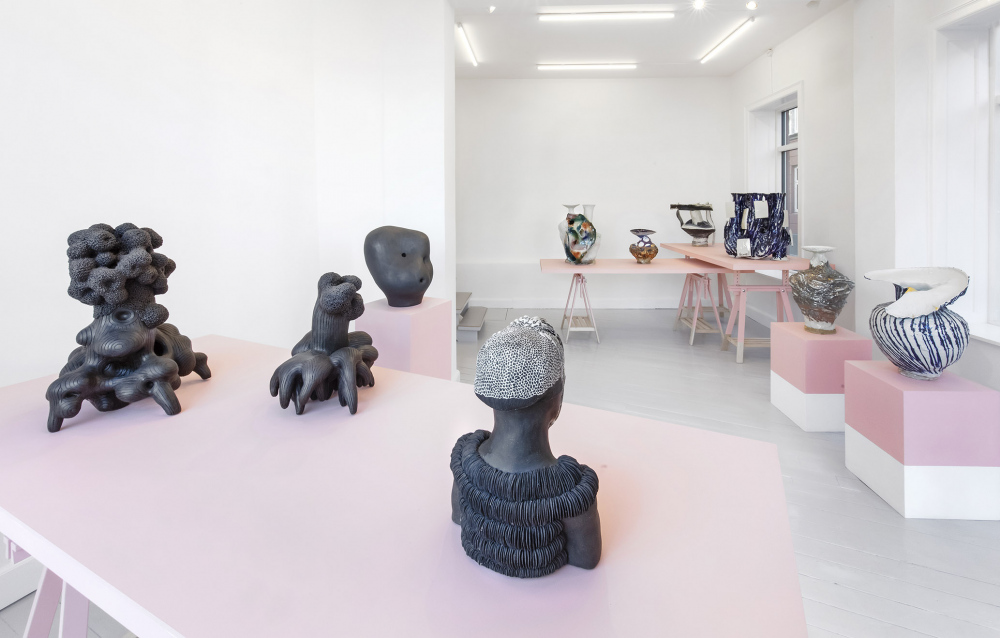
Photo by Ole Akhøj
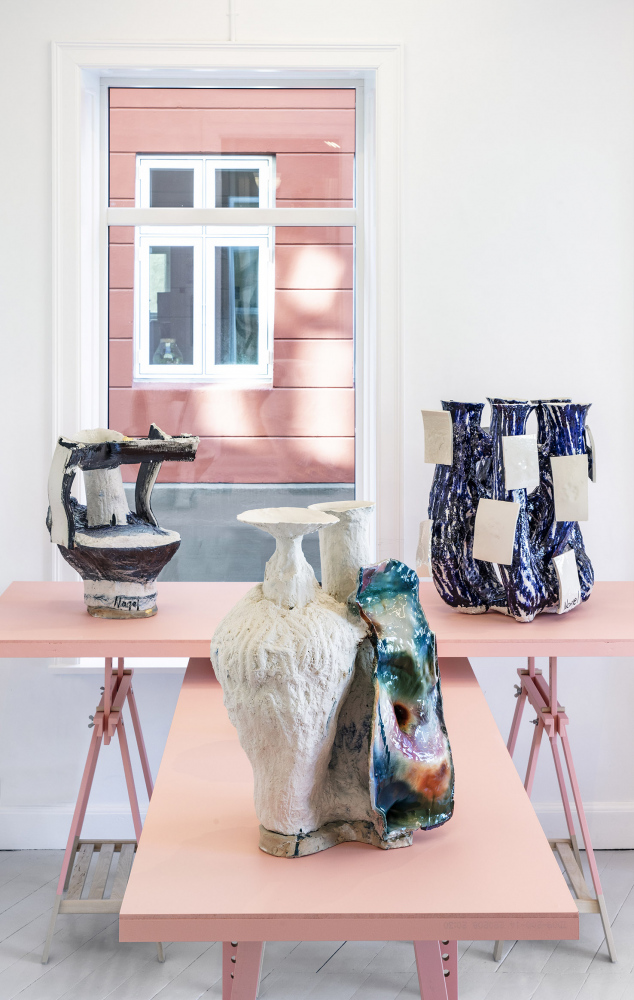
Photo by Ole Akhøj
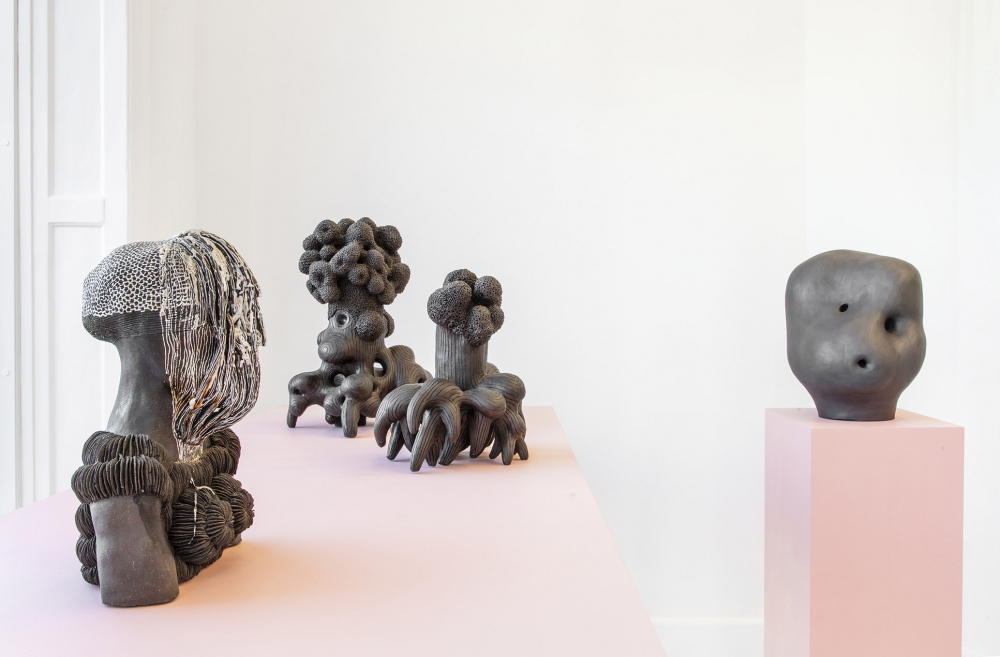
Photo by Ole Akhøj
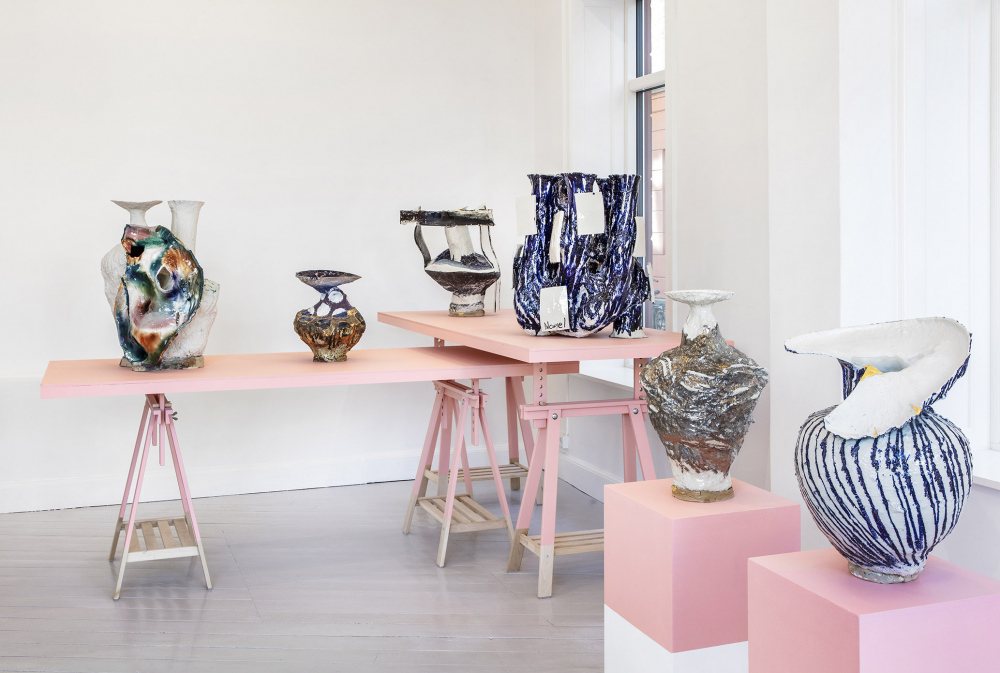
Photo by Ole Akhøj
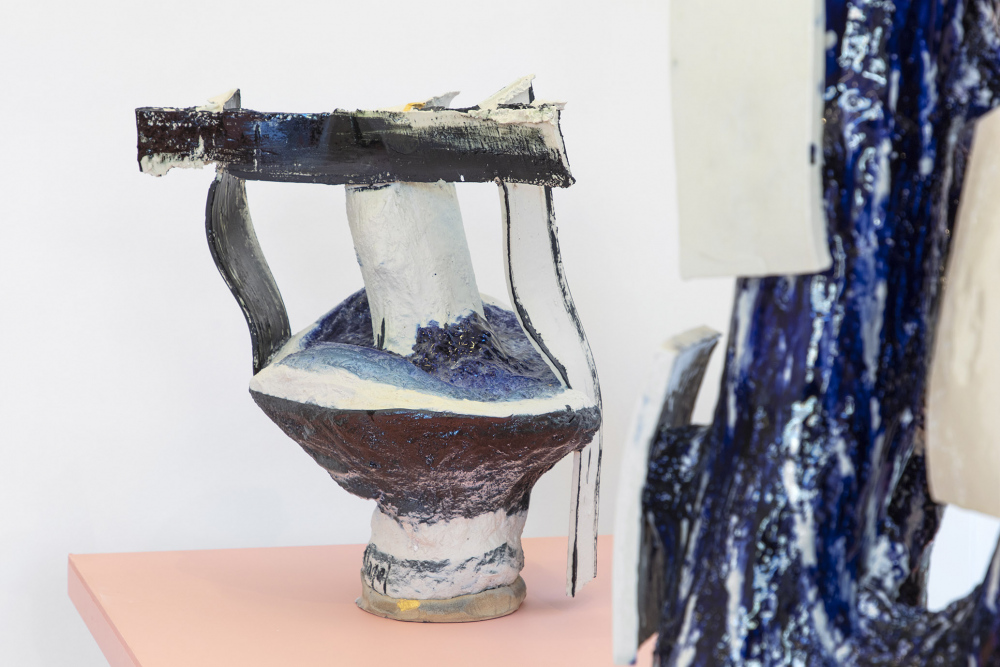
Photo by Ole Akhøj
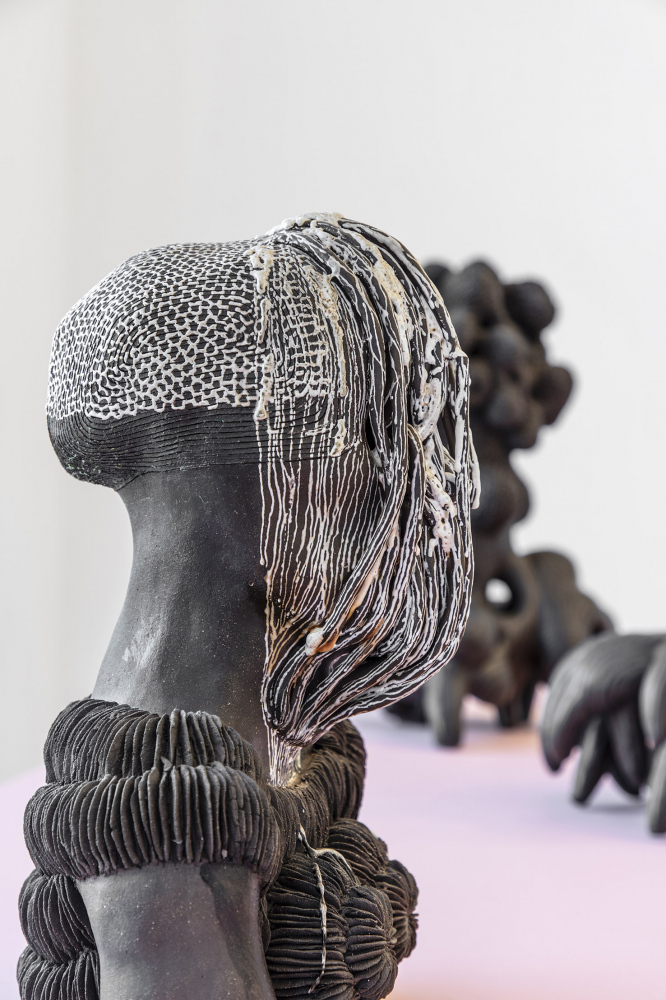
Photo by Ole Akhøj
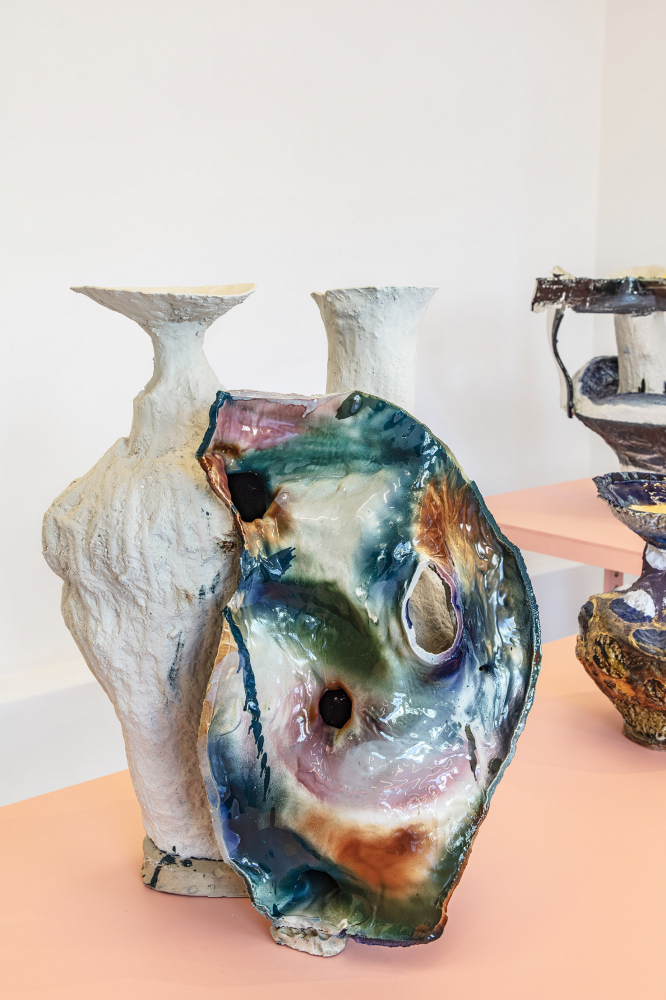
Photo by Ole Akhøj
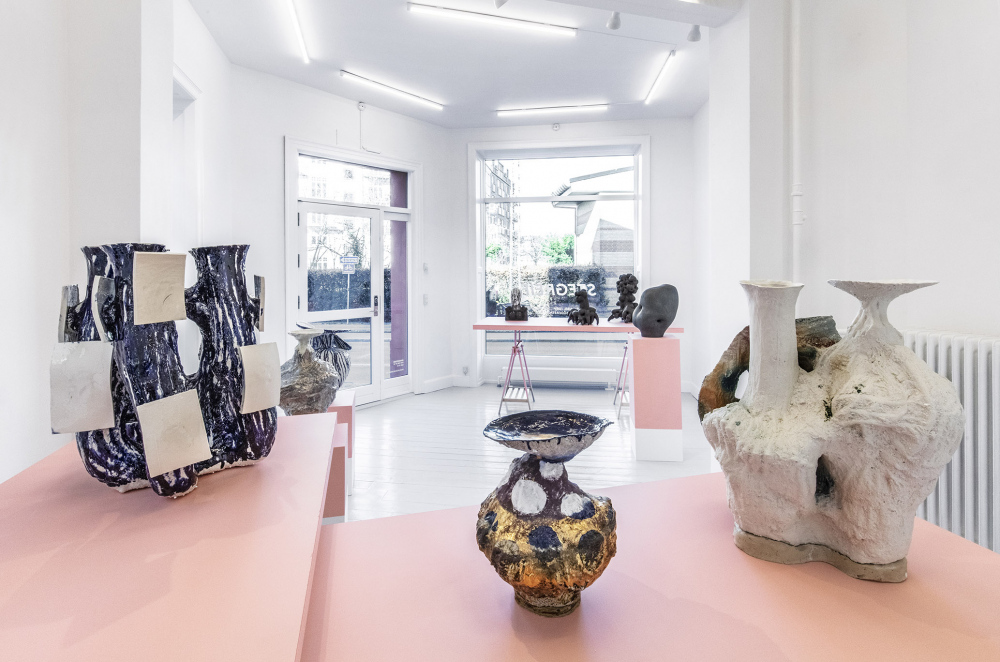
Photo by Ole Akhøj
STEGREIF
Johannes Nagel (DE) and Carl Richard Söderström (SE)
3 March – 9 April 2022
The German word Stegreif, chosen as the title for this exhibition, describes the here-and-now moment, liberated from prior planning. Literally, it means ‘without descending from your horse’ and can thus be seen as an apt metaphor for the processual situation of unpremeditated artistic improvisation.
Improvisation, whether in music or in the visual arts, presupposes great knowledge and skill of which you temporarily let go in order to arrive at new, unpredictable results, states and energy in your work. Maybe provisionally, maybe taken to a finalized expression. For both artists in the exhibition, this tentative approach is an essential aspect of their work.
The specific subject of Johannes Nagel’s work is the improvised and provisional. The objects are finished, in that the porcelain is painted (glazed) and fired. Most objects are somehow vessels or pots. What else are they? An attempt to confuse the connotations that technique and material provoke. At times constructive composing, at times willful destruction, sometimes vases, sometimes fragments or alienated objects.
Using work techniques such as burrowing into sand to form negative figurations for casting, he successfully performs his work directly and manually, lending the process of searching a tangible presence. The joints and fissures, the blots of colour and unfinished painting appear provisional as they point from the finished object back to the process. It is not the perfection of the ultimate expression that is intended but the verbalization of a concept of the evolution of things.
Carl Richard Söderström’s work springs from structures and segments of nature – nature which, influenced by humans, later seeks to regain an original form without any other ambition than adapting and living on, liberated from aesthetic and otherwise valued positions. He moves between a purely abstract and a more figurative formal language, always with layer upon layer of forms and structures.
Carl Richard Söderström describes his choice of ceramics as an artistic medium as coincidental. In his striving to express himself freely, he found ceramic practice to be least burdened by artistic models or expectations. His entire artistic practice rests precisely on relating freely to his own creation, rooted in an intuitive making that goes beyond rational systems and theoretical models. The process directs the expression, and coincidences challenge the safe and familiar and thus drive his artistic development forward.
Both artists have exhibited widely in their home countries as well as internationally. This exhibition marks their first presentation in Denmark.
Johannes Nagel’s works are represented in many public collections, including Victoria and Albert Museum in London, Grassi Museum in Leipzig and Museum Princessehof National Museum of Ceramics in Leeuwarden, the Netherlands.
Carl Richard Söderström is represented in the collections of the Swedish Arts Council, Musée National de Céramique de Sèvres in Paris and Röhsska Museum in Gothenburg, among others.
Download press release + images
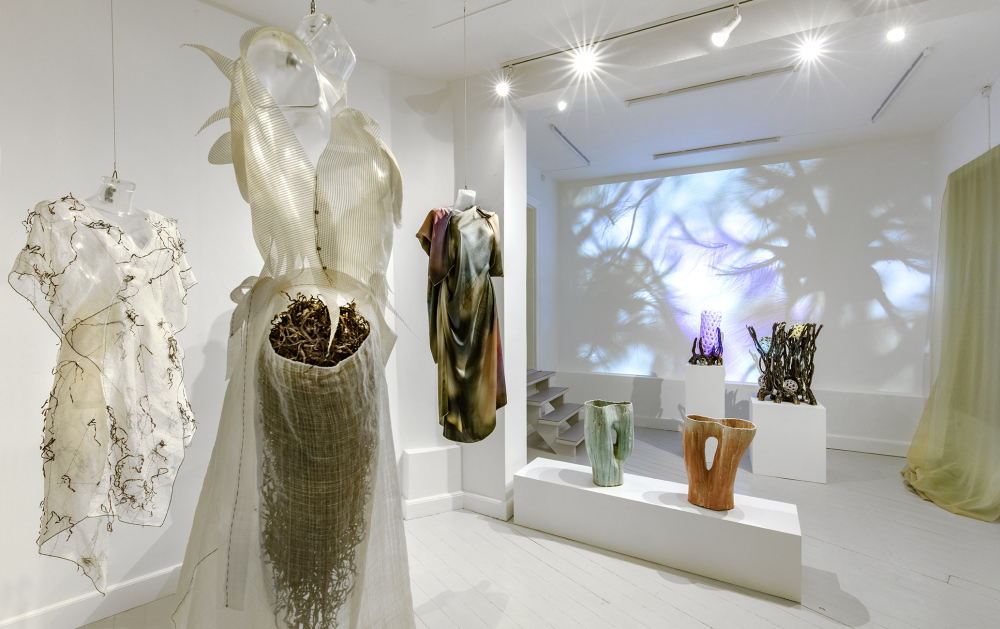
Photo Ole Akhøj
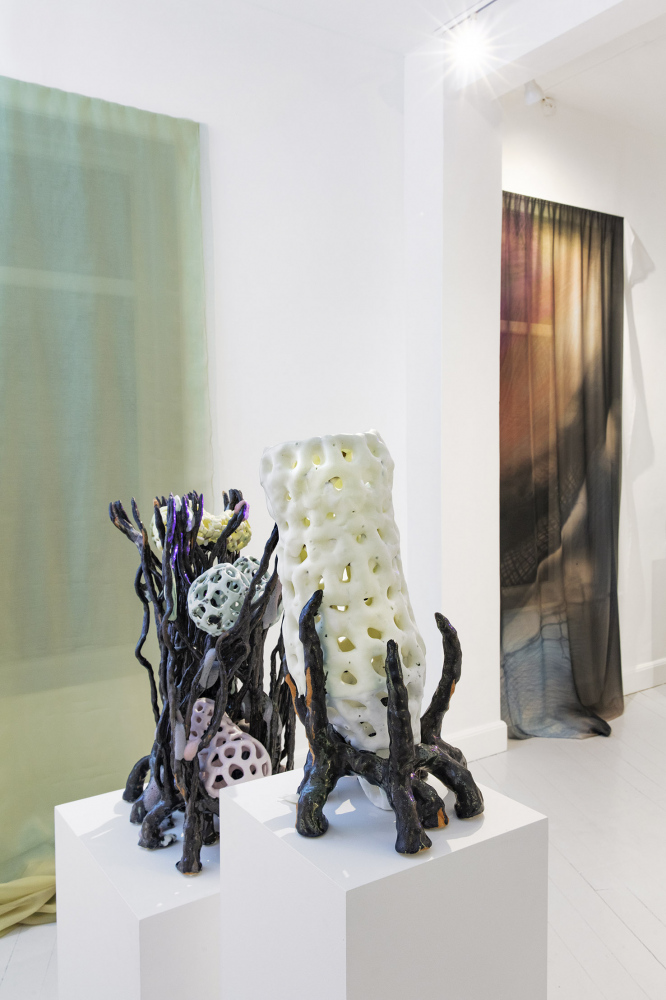
Photo Ole Akhøj
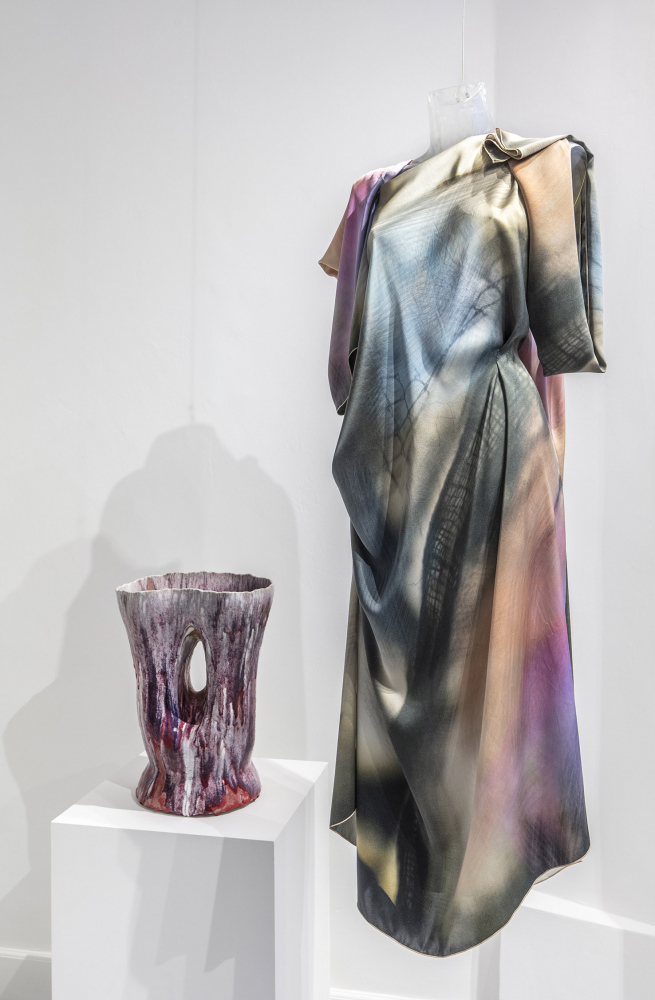
Photo Ole Akhøj
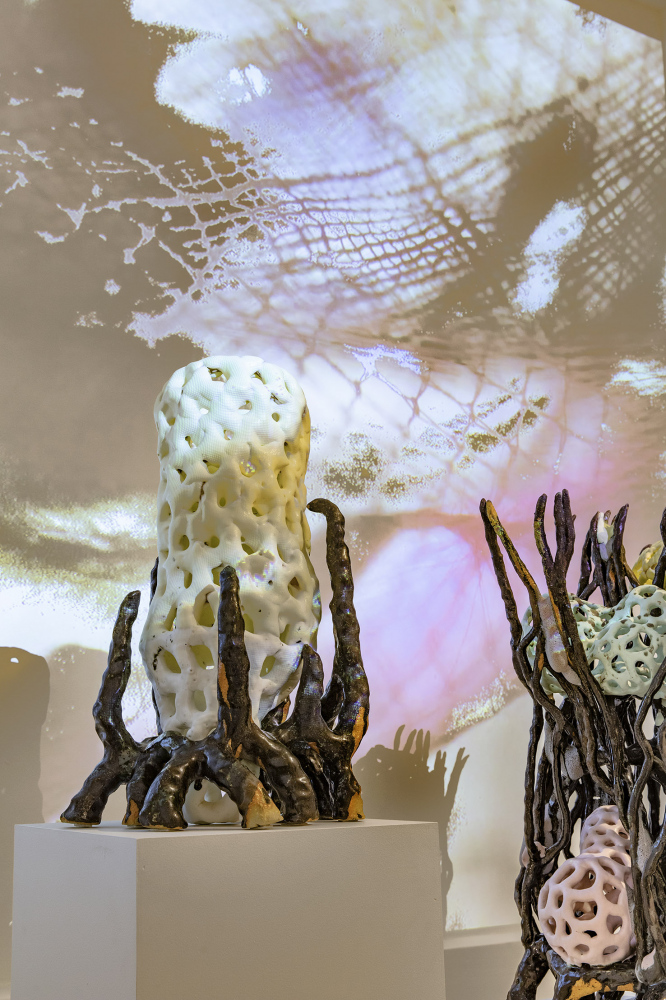
Photo Ole Akhøj
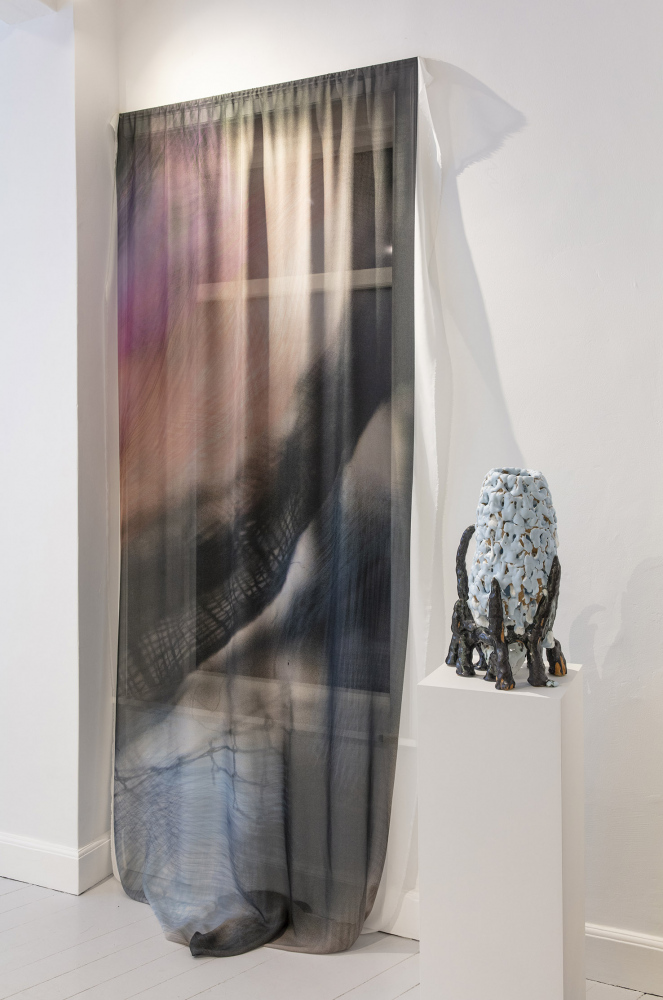
Photo Ole Akhøj
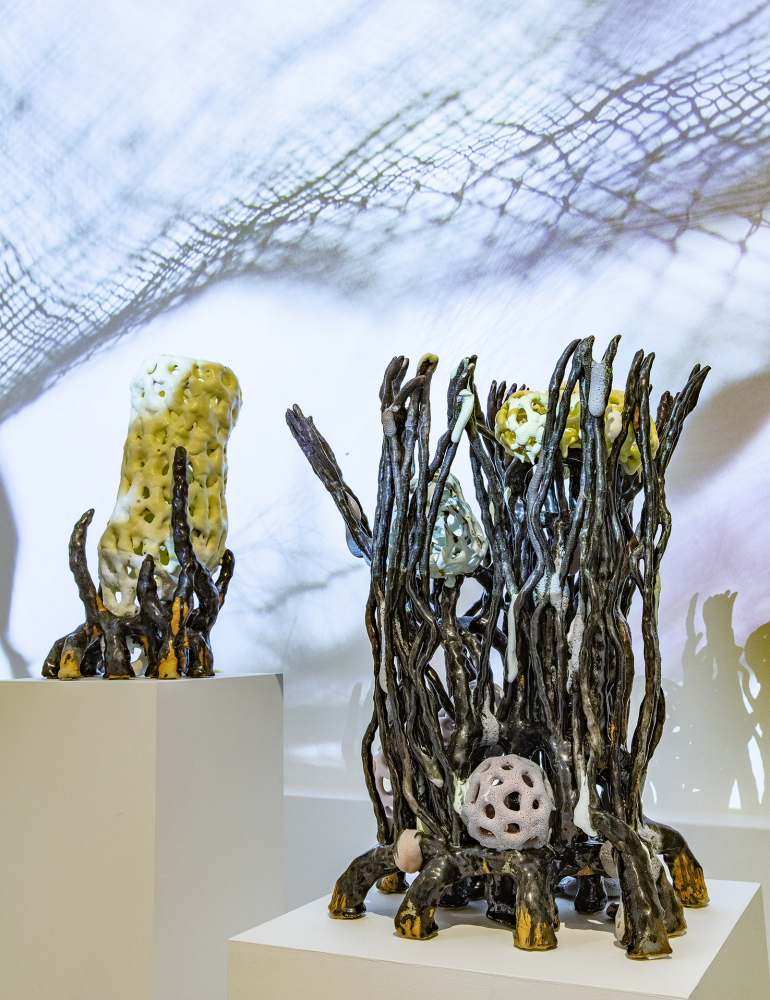
Photo Ole Akhøj
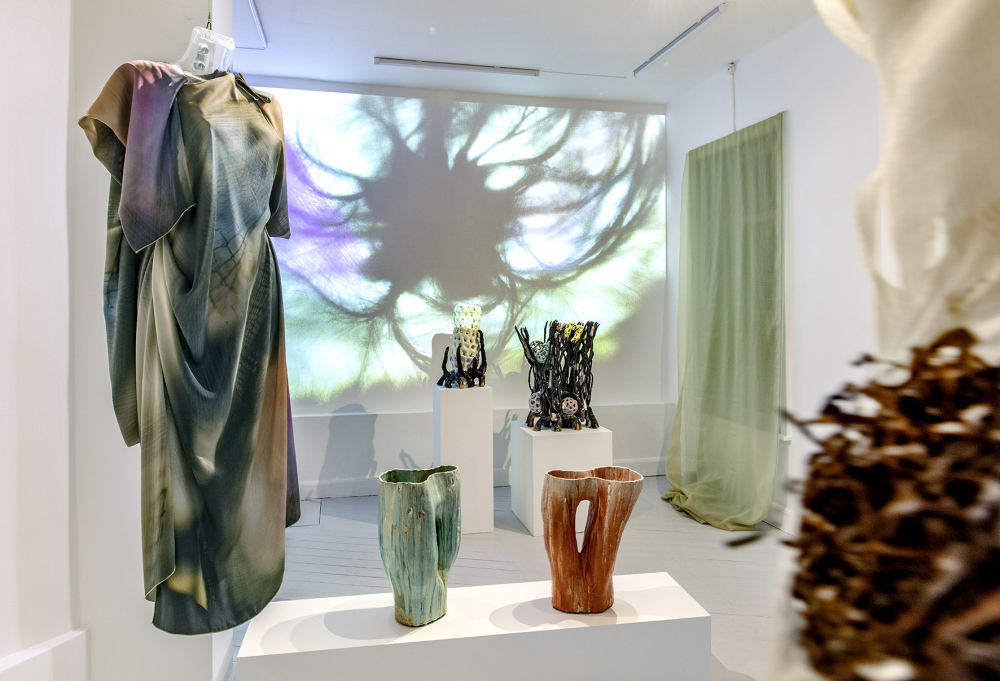
Photo Ole Akhøj
Everything Flows
Bente Skjøttgaard & Anne Damgaard
21st January - 26th February 2022
The exhibition Everything Flows (Heraclitus 540–480 BCE) offers a sensuous and dramatic immersive experience of light, sound, flowing garments and undulating forms.
Ceramic artist Bente Skjøttgaard’s and fashion designer Anne Damgaard’s distinctly different artworks are presented in a close interplay, tied together by a shared underwater theme that unfolds in fluid shapes and colours. Skjøttgaard’s large ceramic abstractions on nature contain references to jellyfish and other marine species captured in fluid motion, while Damgaard’s sculptural textile constructions include transparent materials and seaweed as well as experiments with photographic shadow images that produce a shimmering sensation of light under water.
The two artists’ collaboration springs from a common artistic approach driven by experimental lightness. They both work with clear formal contrasts, such as gravity versus lightness and taut structure versus the dissolved and diffuse. Each in their way, they also both challenge the relationship between spontaneity and control and allow chance to play a deciding role. Damgaard’s work is based on basic geometric shapes that are cut into gauzy textiles, which are then draped and hung in a varying interplay of lines, while Skjøttgaard hands a measure control to the high temperatures in the kiln during firing, allowing gravity and the flow of the glazes to influence the outcome.
About the artists:
Fashion designer Anne Damgaard creates textile constructions and unique dresses disconnected from time and place, fashion or functional purpose. In tulle and gauze and mesmerizing interplays of colour they float freely in their own magical universe.
Anne Damgaard (b. 1968) trained at the Royal Danish Academy, 1992–97. Selected exhibitions: All Solid Melts into Air, duo with Bente Skjøttgaard, Kunstpakhuset, Ikast, 2020; Structured, group show, Site131, Dallas, TX, 2019; Revner og Sprækker (Cracks and Crevices), trio, Gammelgaard, Herlev, 2018; Biennale for Craft & Design, Koldinghus, 2021; Rococo Mania, Designmuseum Danmark, Copenhagen, 2012; BLACK ANGELS 13–7, solo, Øksnehallen, Copenhagen. Awards and grants: awards from the Danish Arts Foundation for the solo exhibitions Constructions With Circles Spirals Light, 2010 and A.D.1997–04, 2004; Nordic Award in Textiles, 2008; Inga og Ejvind Kold Christensens Hæderslegat 2007; the Danish Arts Foundation’s three-year working grant 2007–09. Representations: Designmuseum Danmark; Röhsska Museum, Gothenburg; Textilmuseet, Borås; Abecita Konstmuseum, Borås; 100W Corsicana, TX.
Ceramic artist Bente Skjøttgaard challenges the gravity of clay to create organic formations and structures that strive for weightlessness. She balances on the edge of the impossible in explorations that develop into large amorphous nature abstractions with lots of glaze.
Bente Skjøttgaard (b. 1961) trained at Kolding Design School 1982–86. Selected exhibitions: Tableaux, Galerie Maria Lund, Paris, 2021; Bend Bubble and Shine, Copenhagen Ceramics at Hostler & Burrows, New York, NY, and Los Angeles, CA, 2021; All Solid Melts into Air, Anne Damgaard and Bente Skjøttgaard, Kunstpakhuset, Ikast, 2020; Glowing in the Dark, Jason Jacques Gallery, New York, NY, 2020. Representations: Musée des Arts Décoratifs, Paris; V&A, London; Musée National de Céramique de Sèvres, France; Designmuseum Danmark, Copenhagen. Awards and grants: Inga og Ejvind Kold Christensens pris, Nationalbankens påskønnelseslegat, Danish Arts Foundation’s three-year working grant 2001–03, Annie & Otto Johs. Detlefs’ Keramikpris, Ole Haslunds Kunstnerfond. Founding member of the artist-run exhibition spaces Copenhagen Ceramics and Peach Corner.
Sound: Søren Buhl Lassen
The exhibition is supported by the Danish Arts Foundation, Danmarks Nationalbanks Jubilæumsfond and the Danish Art Workshops.
